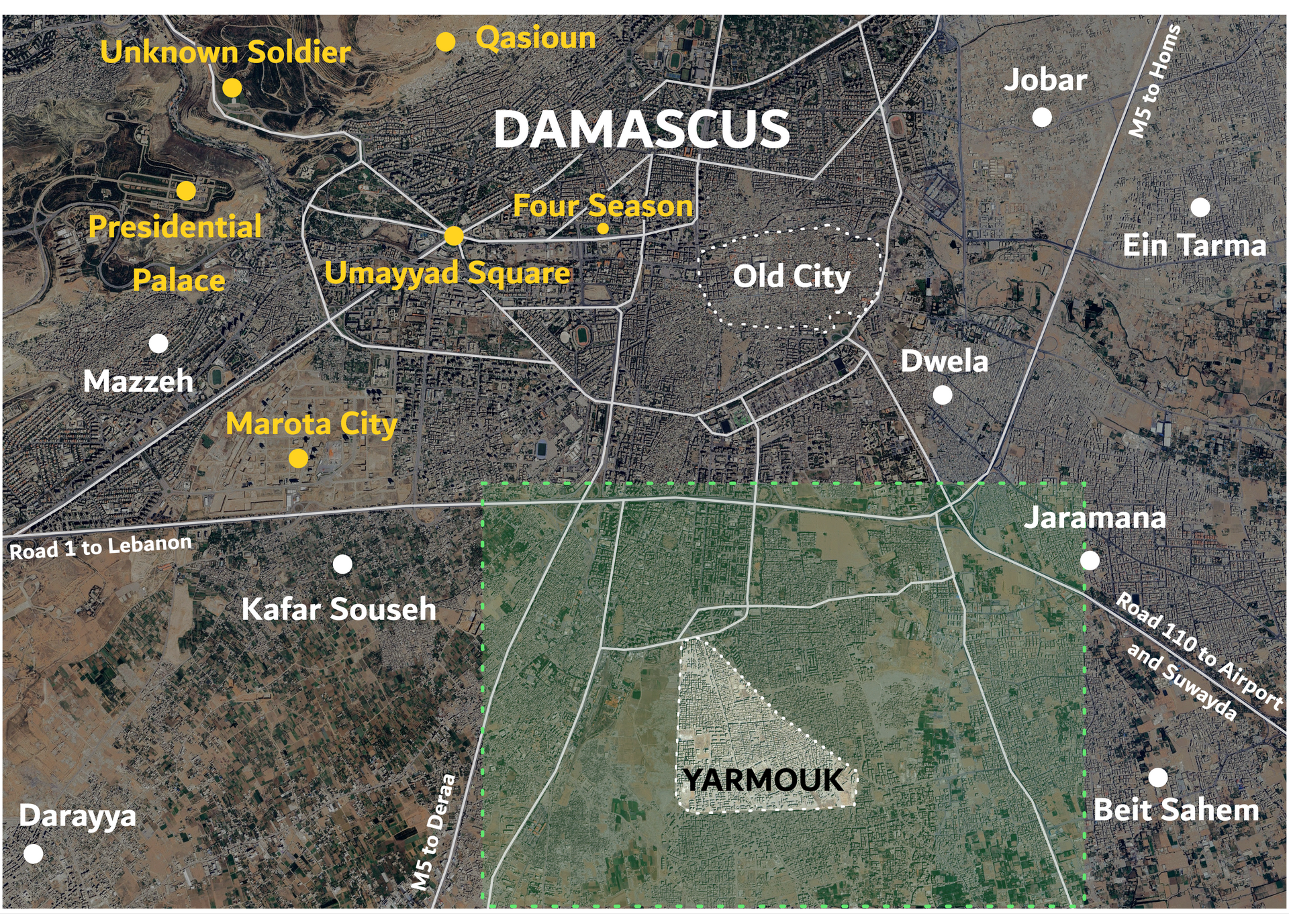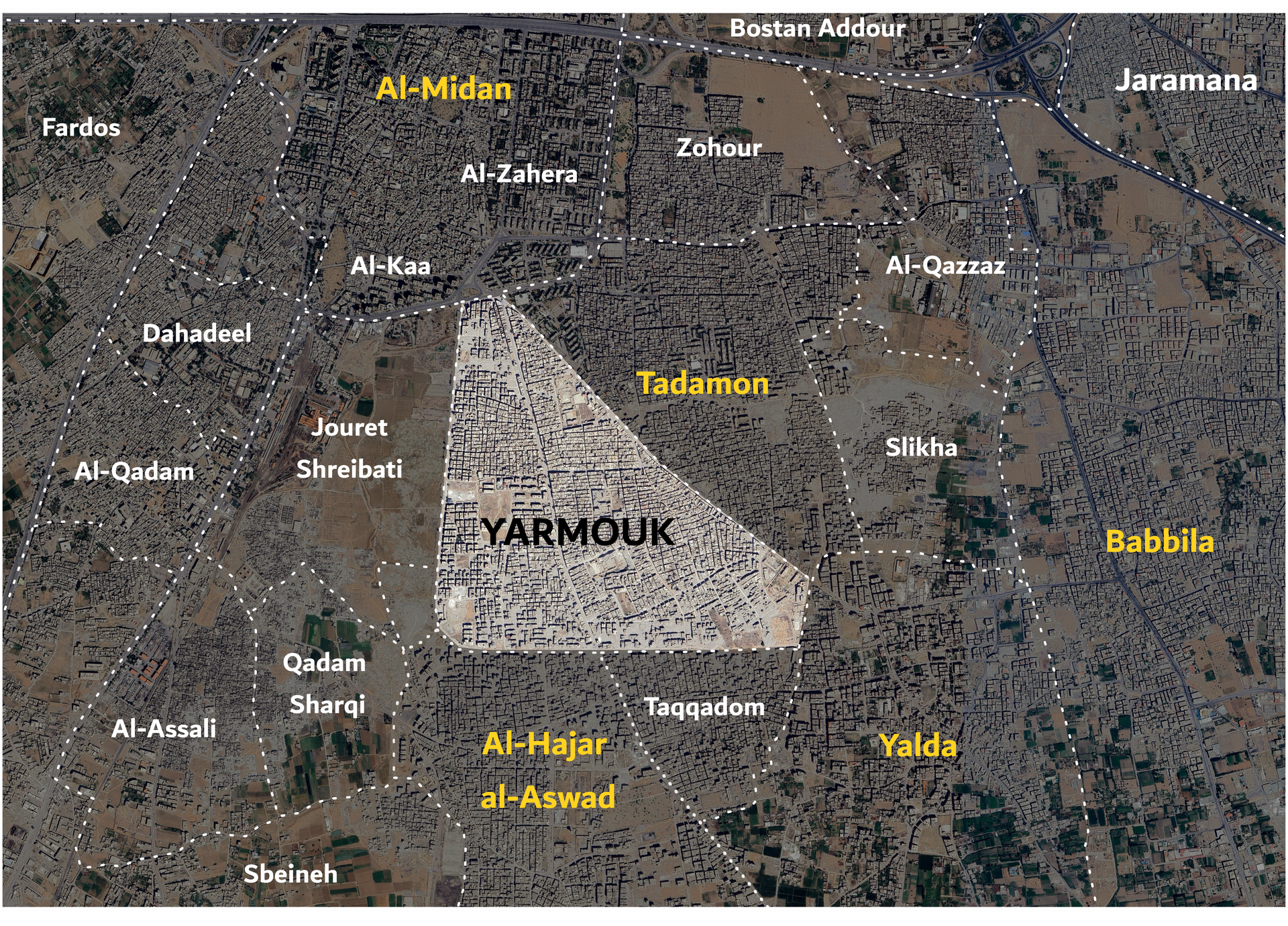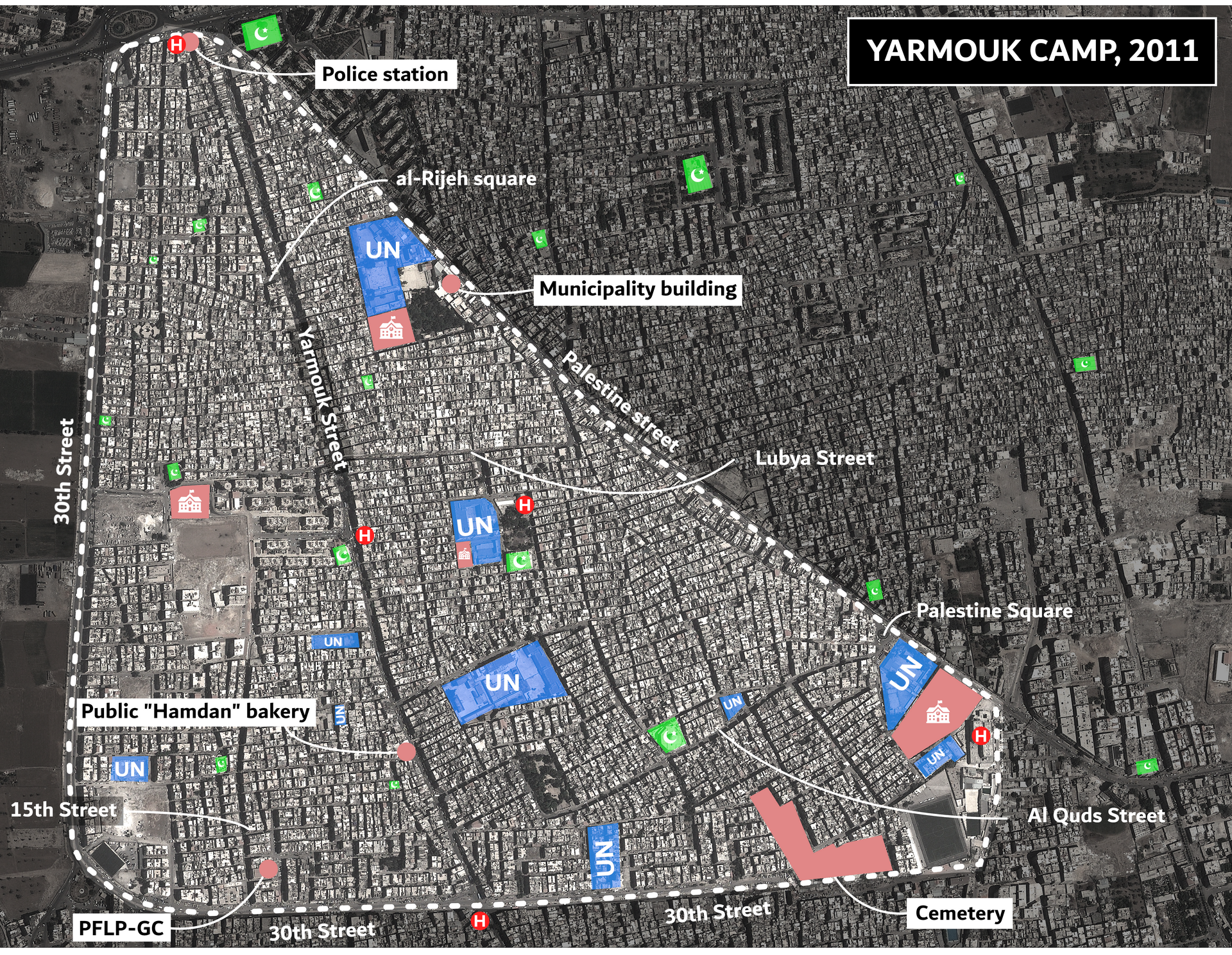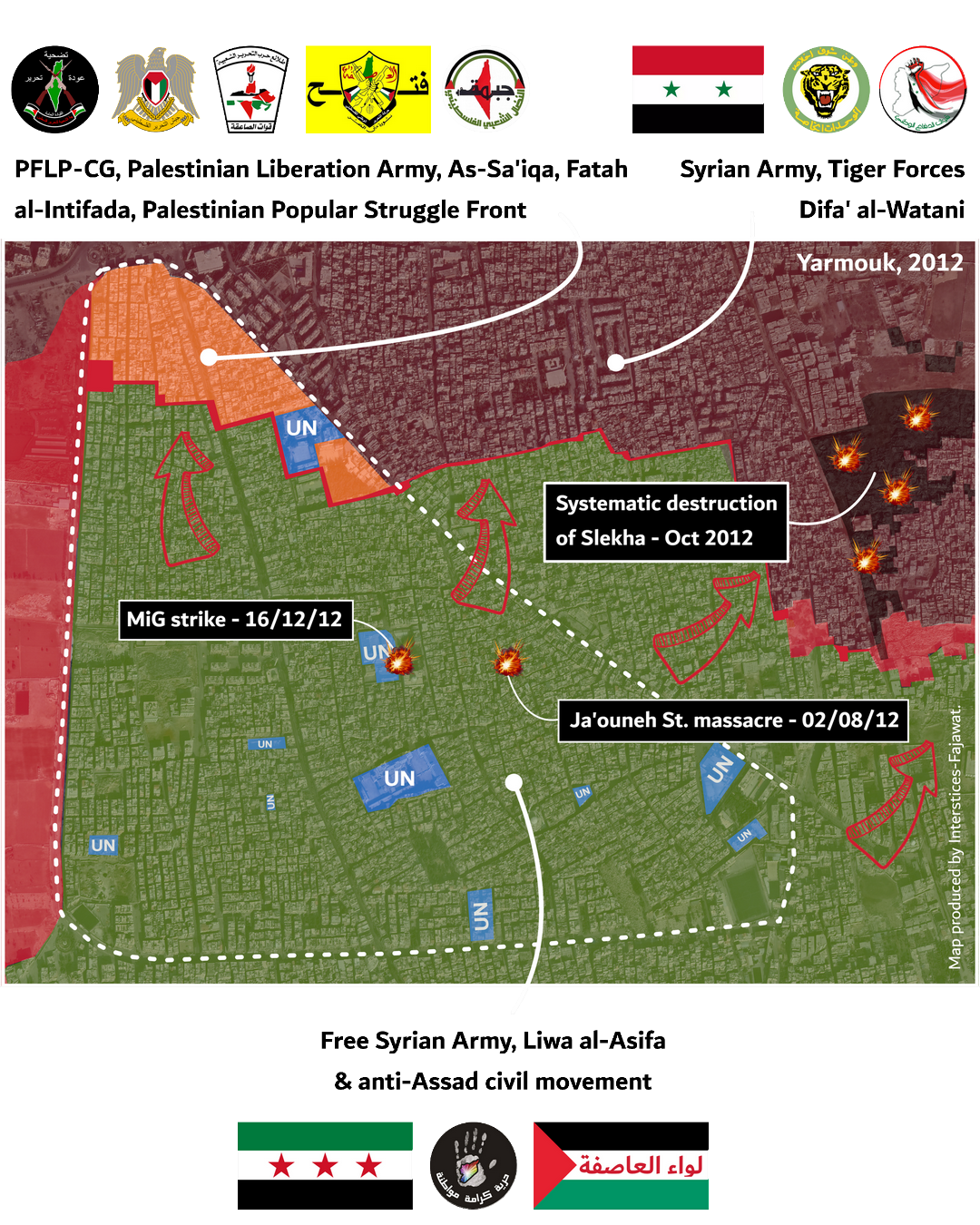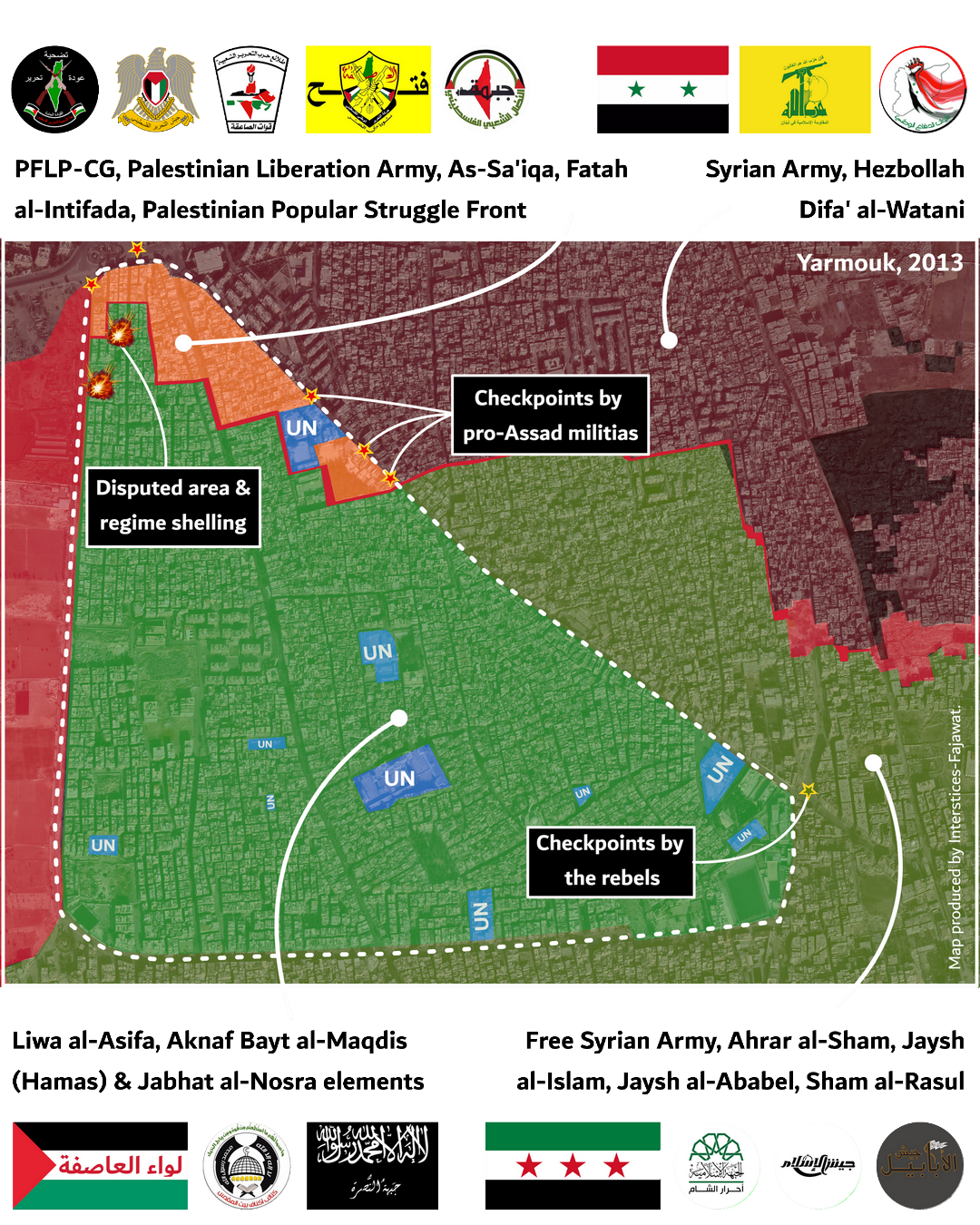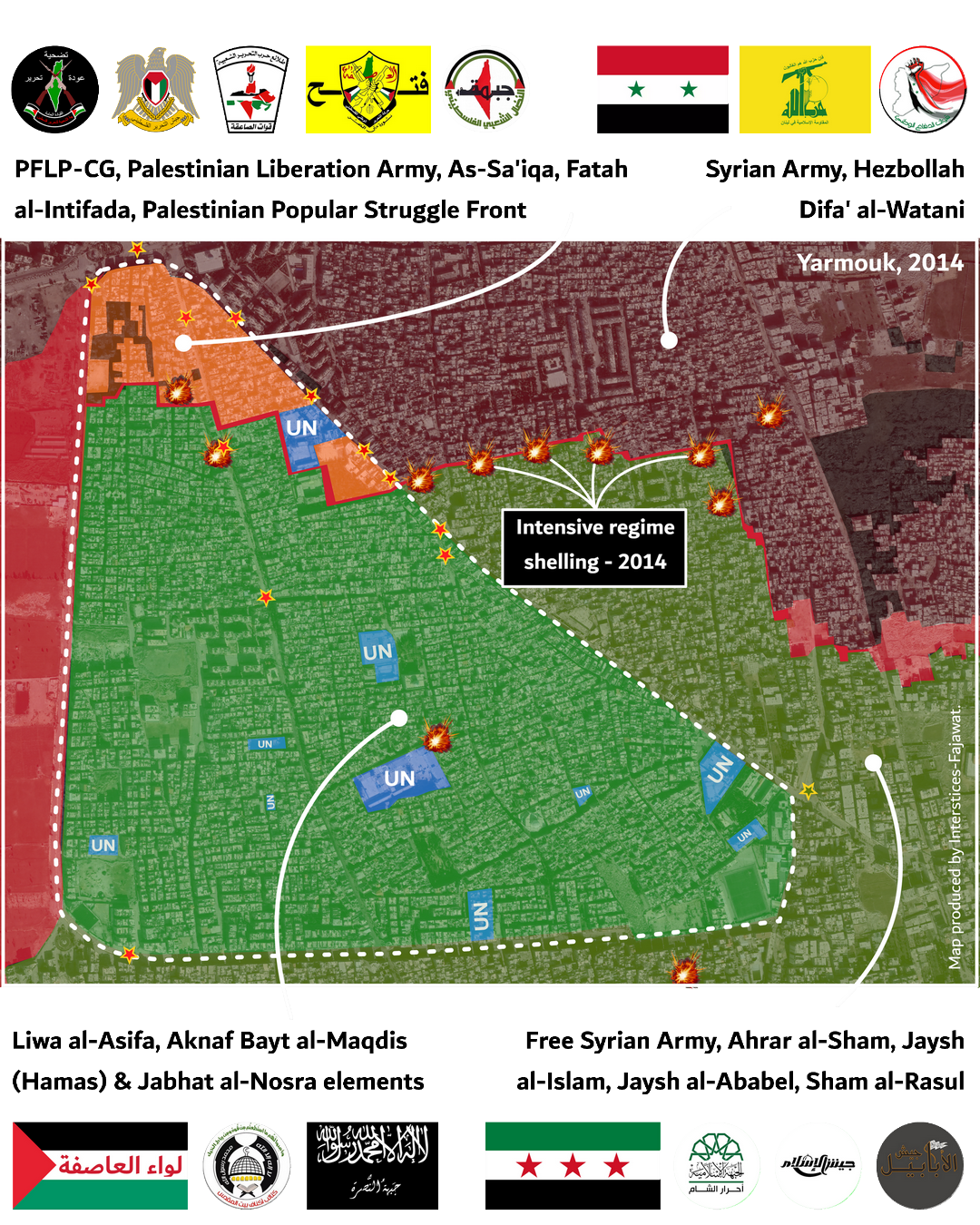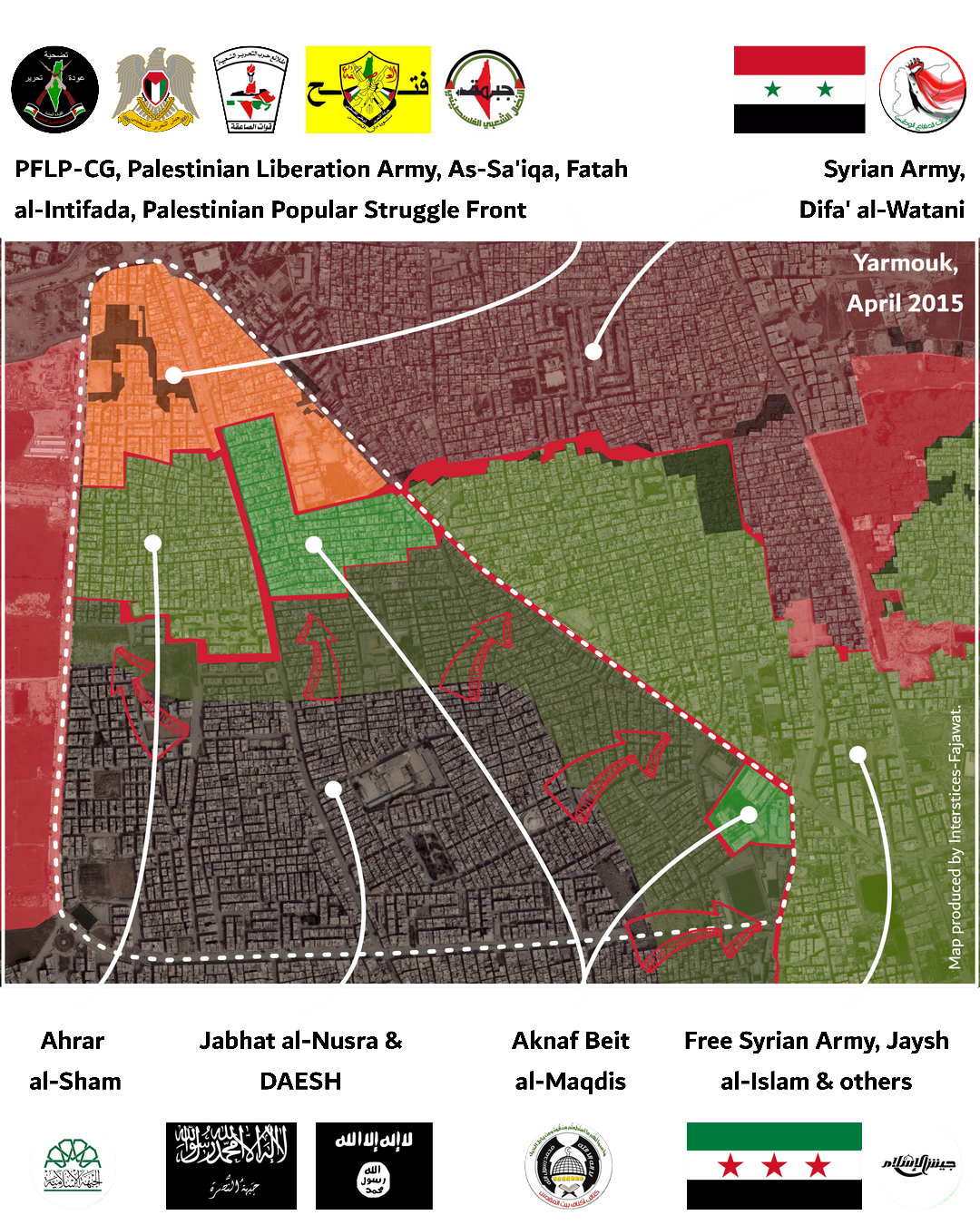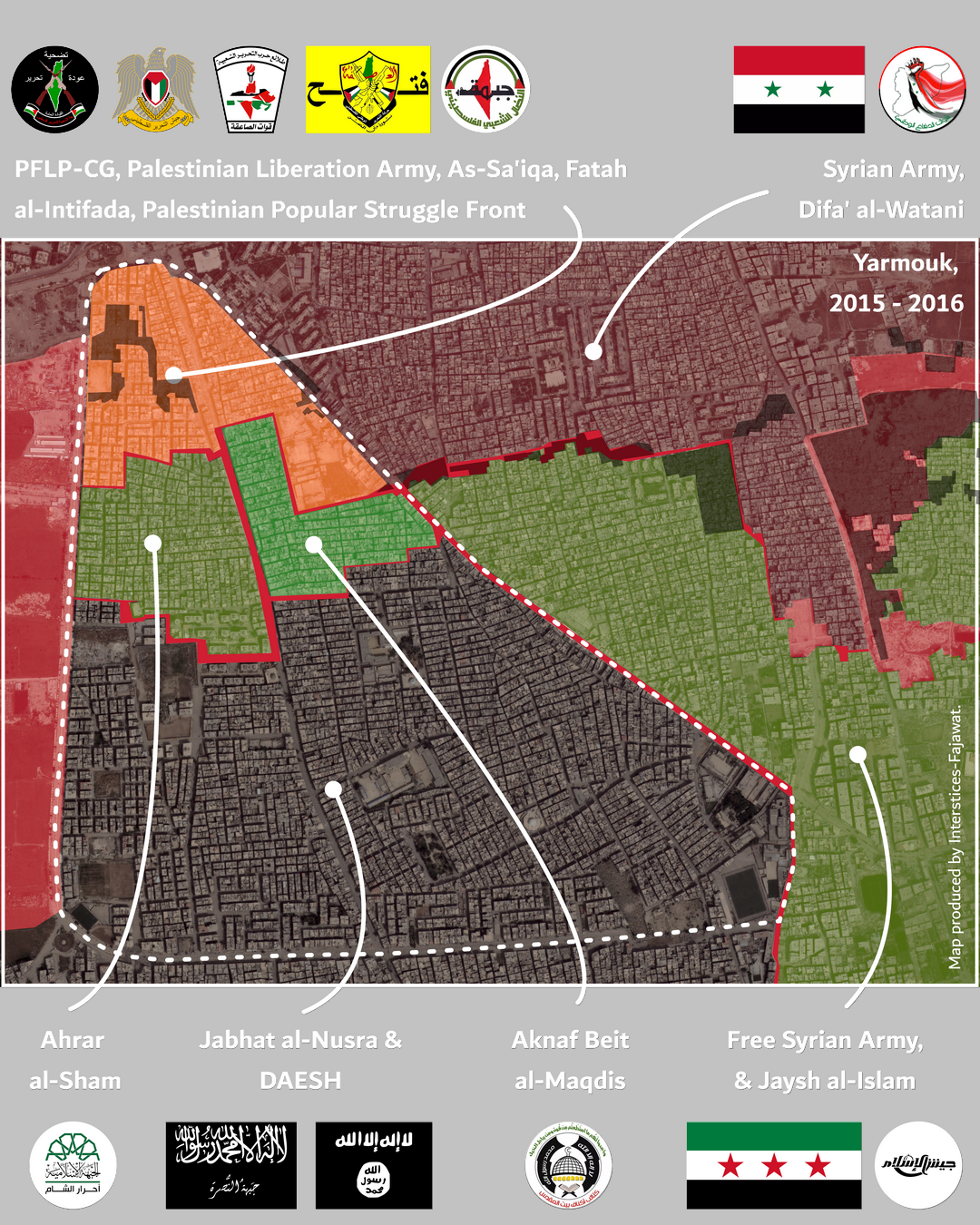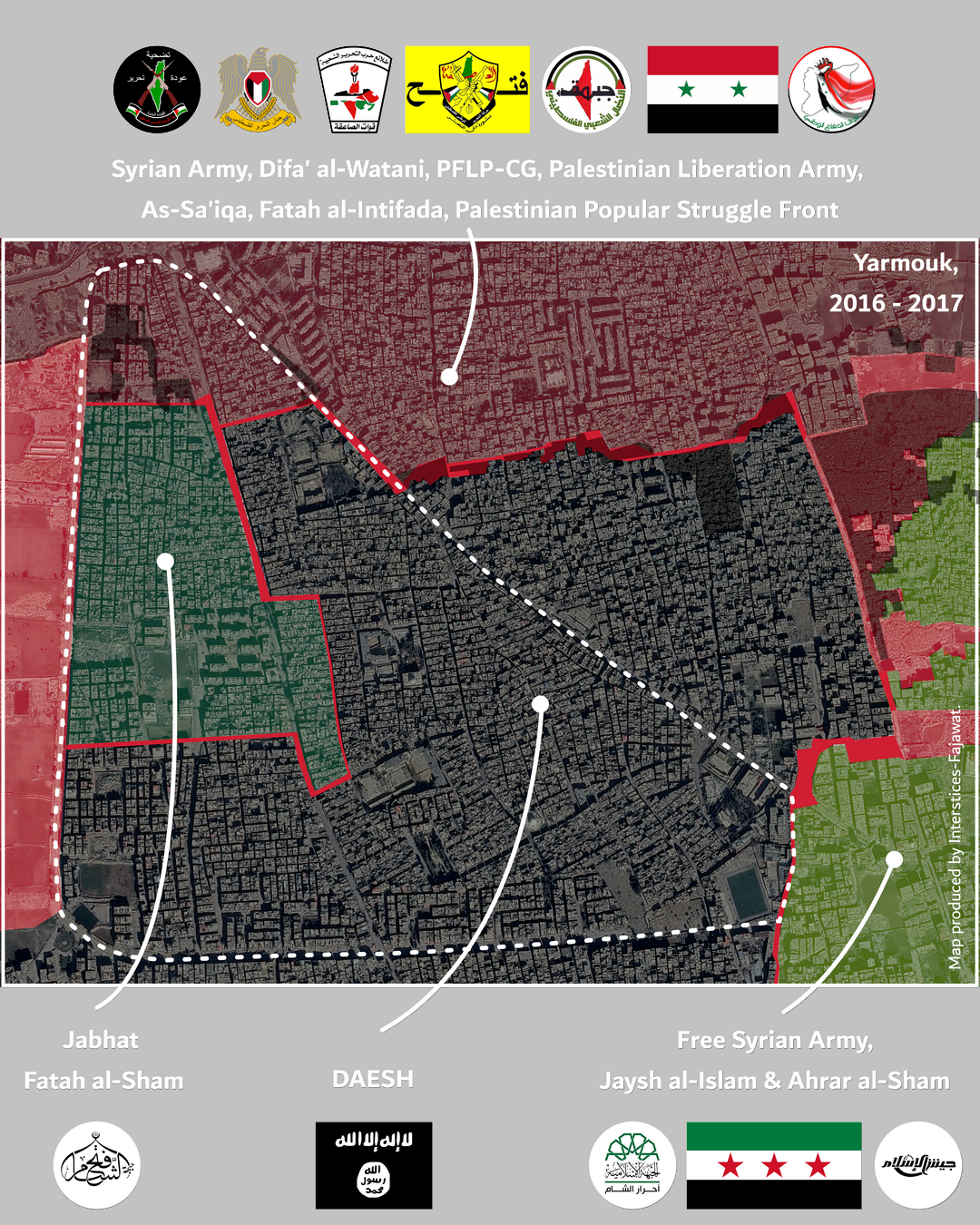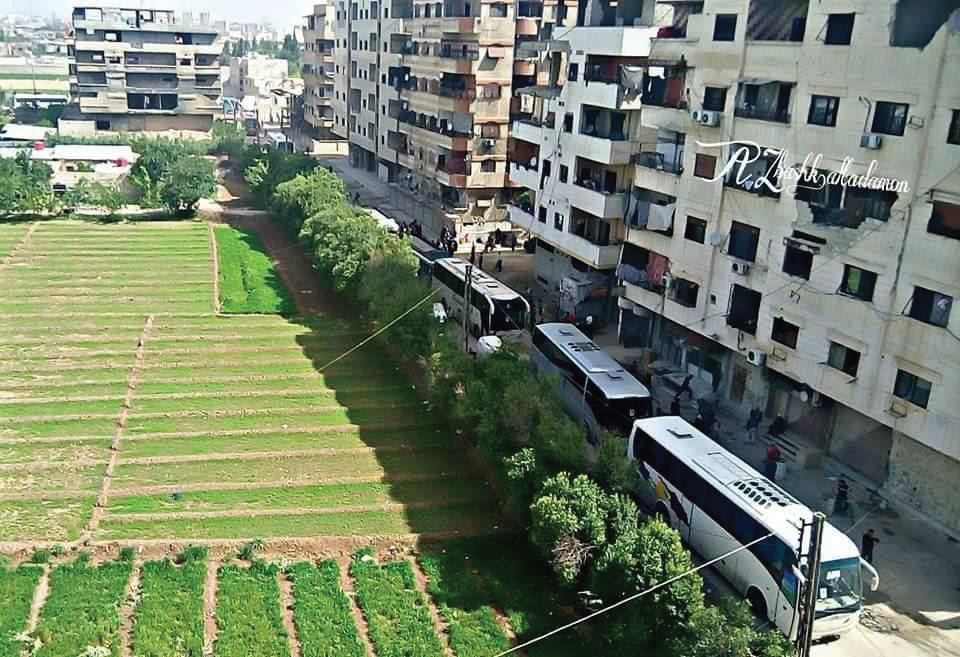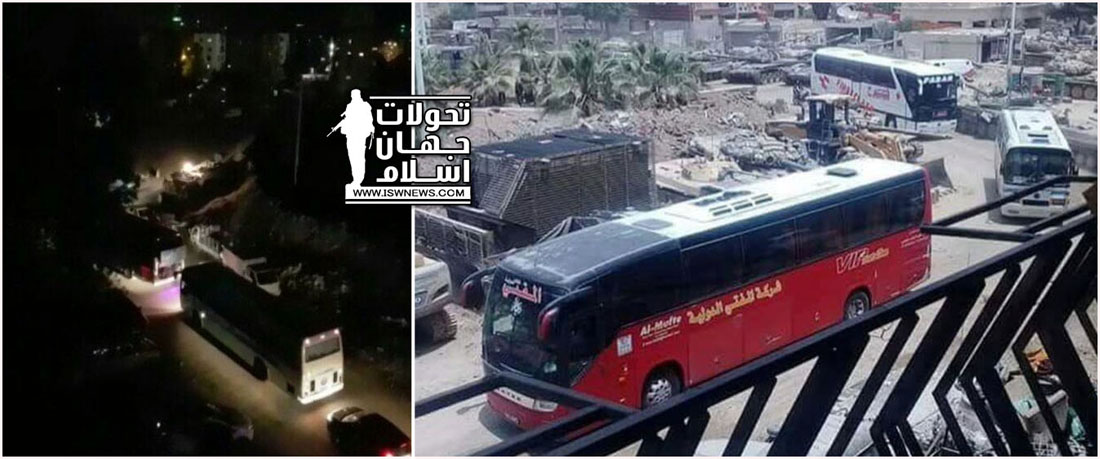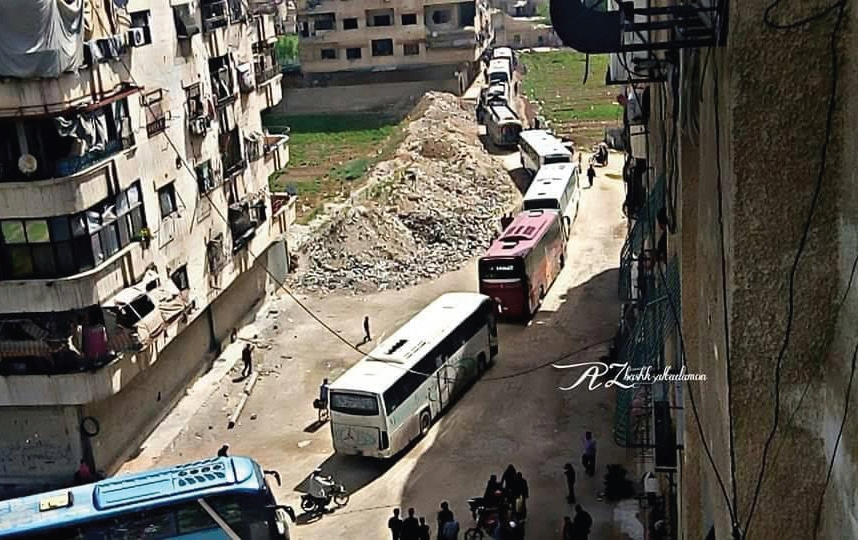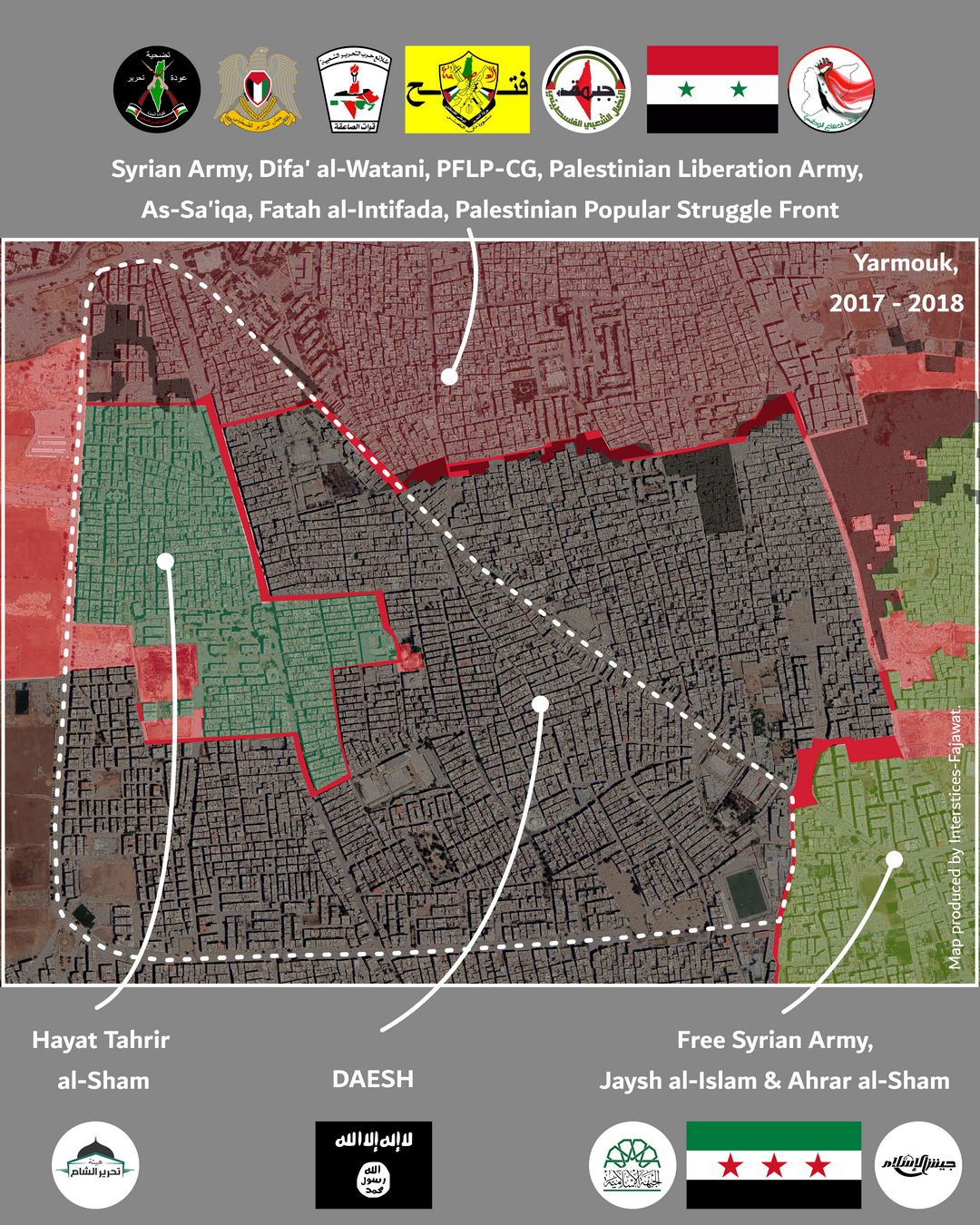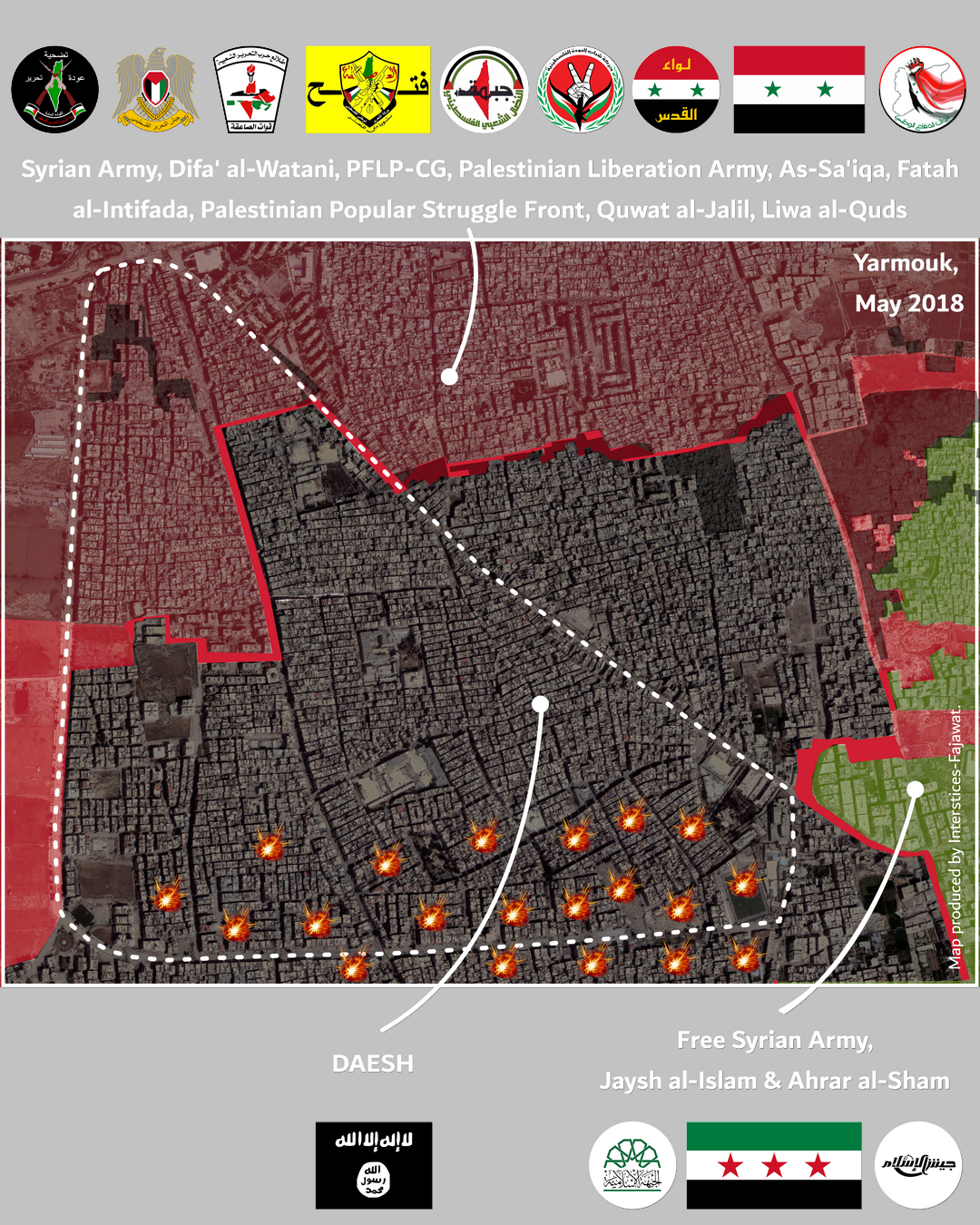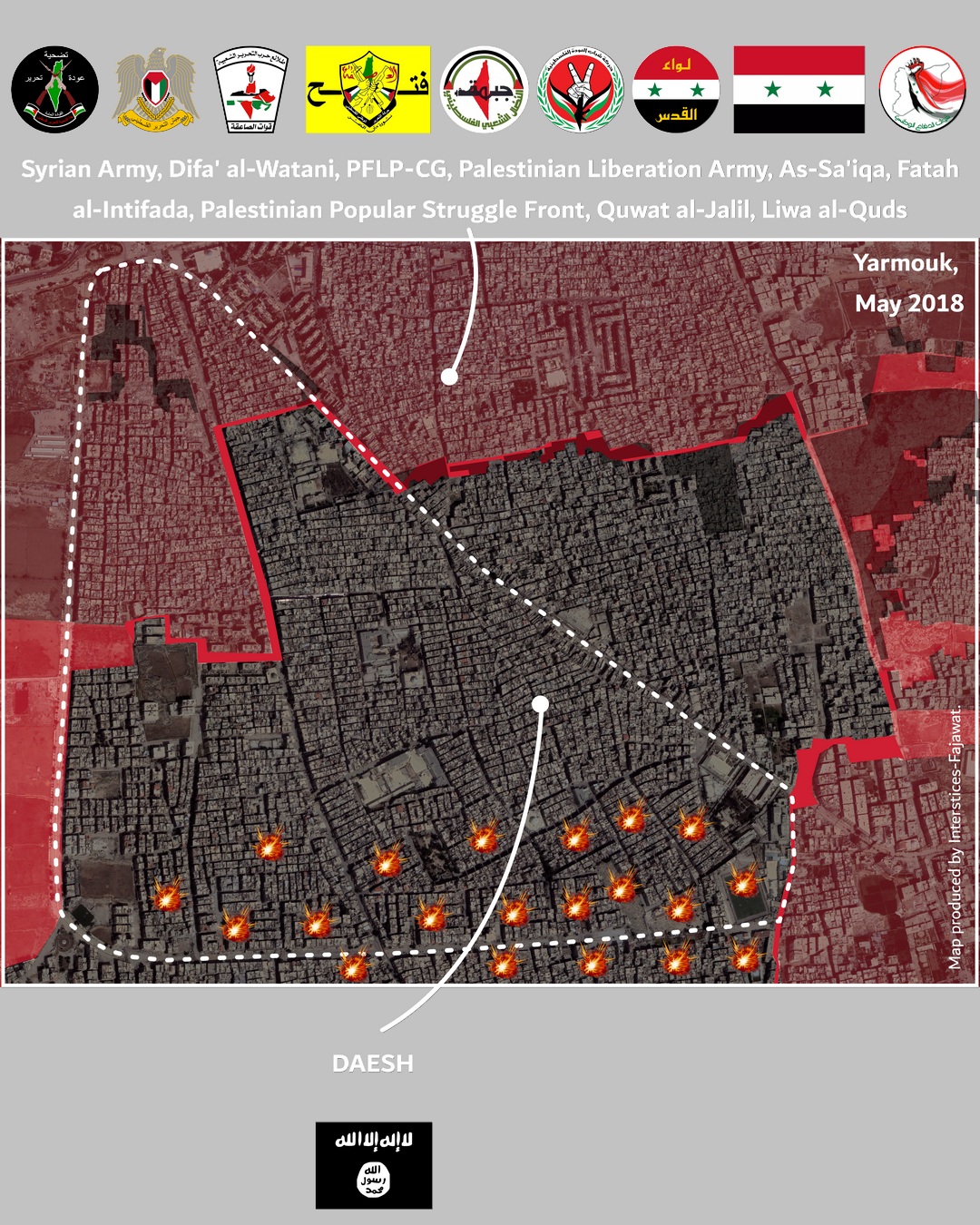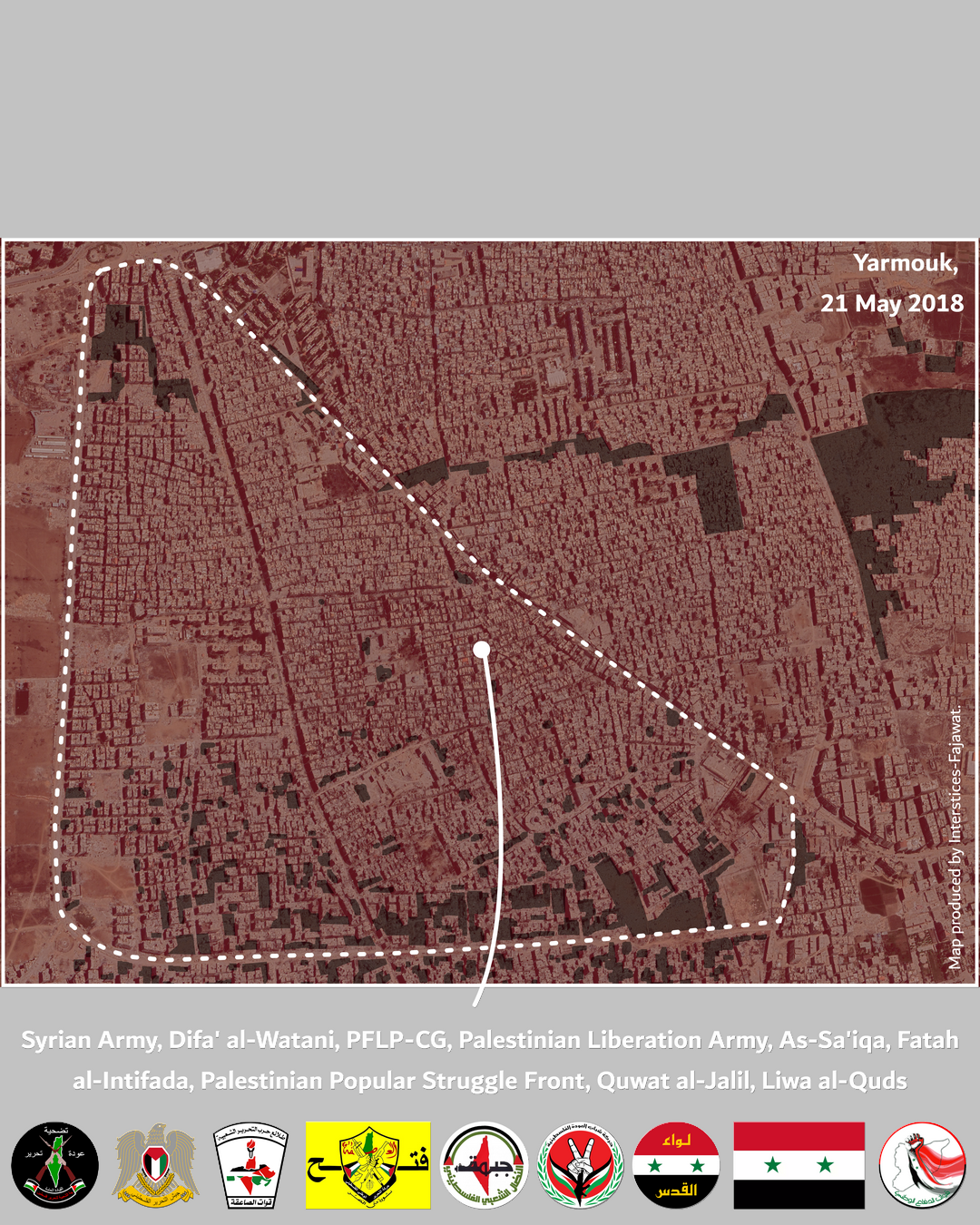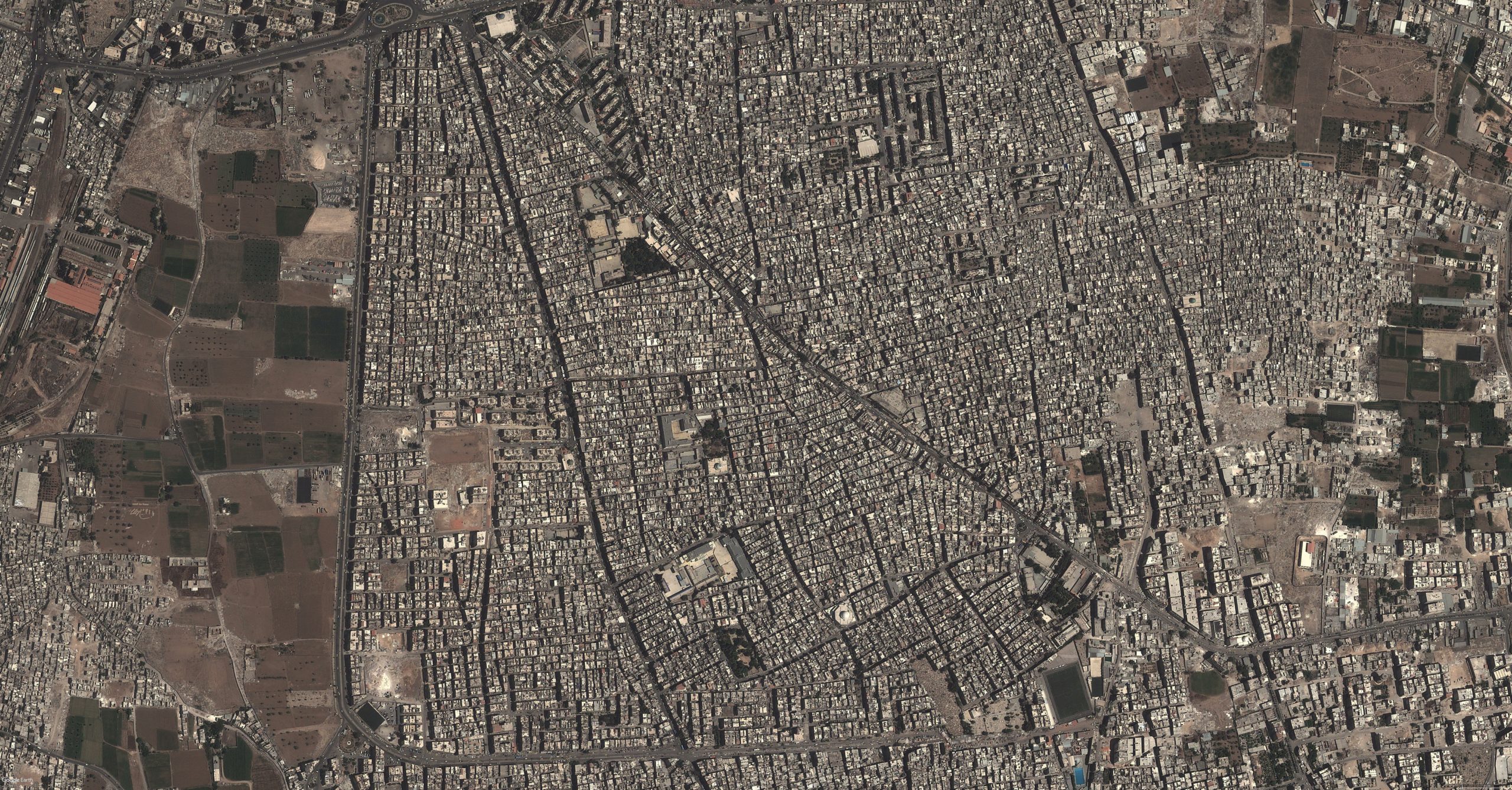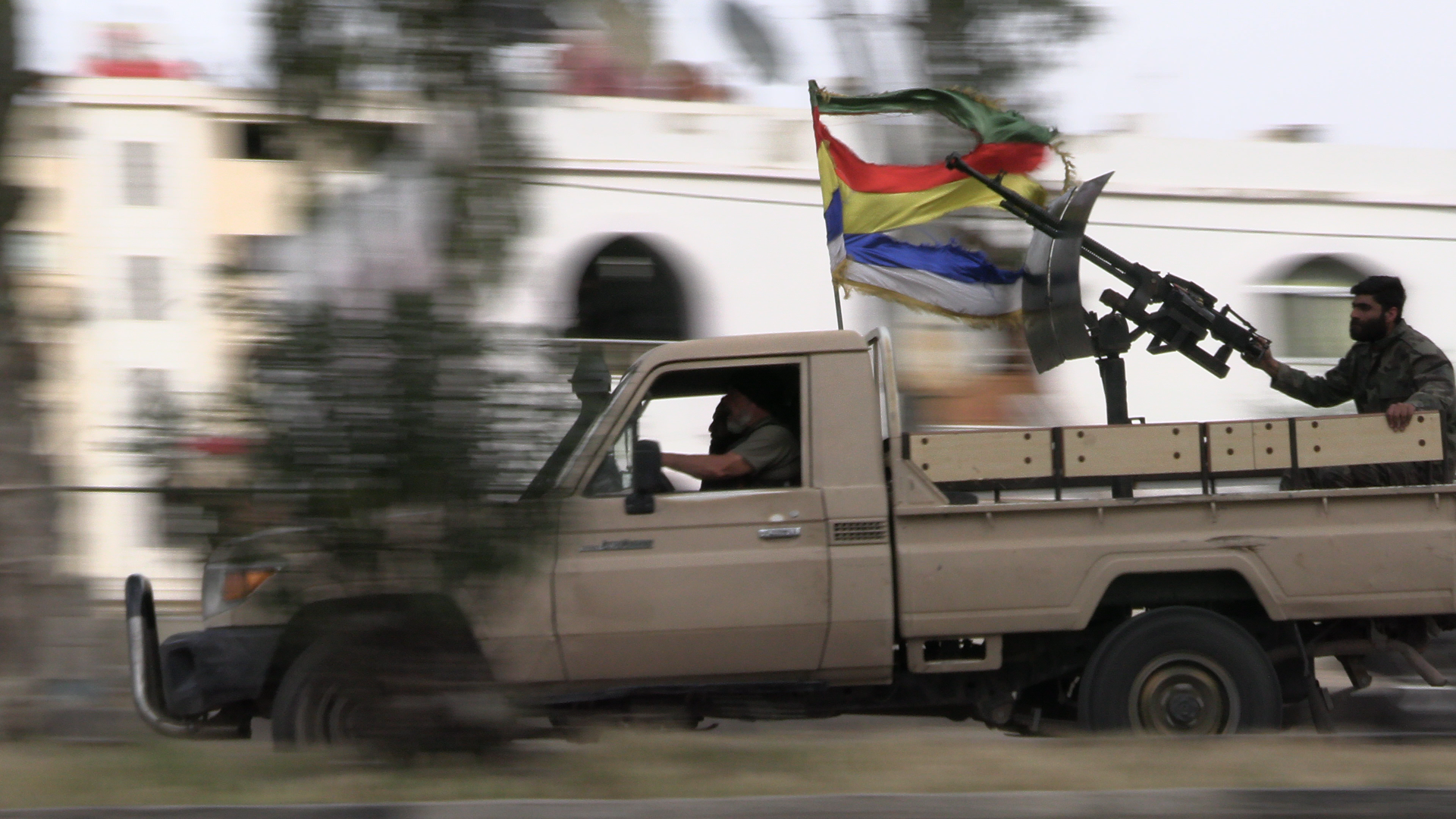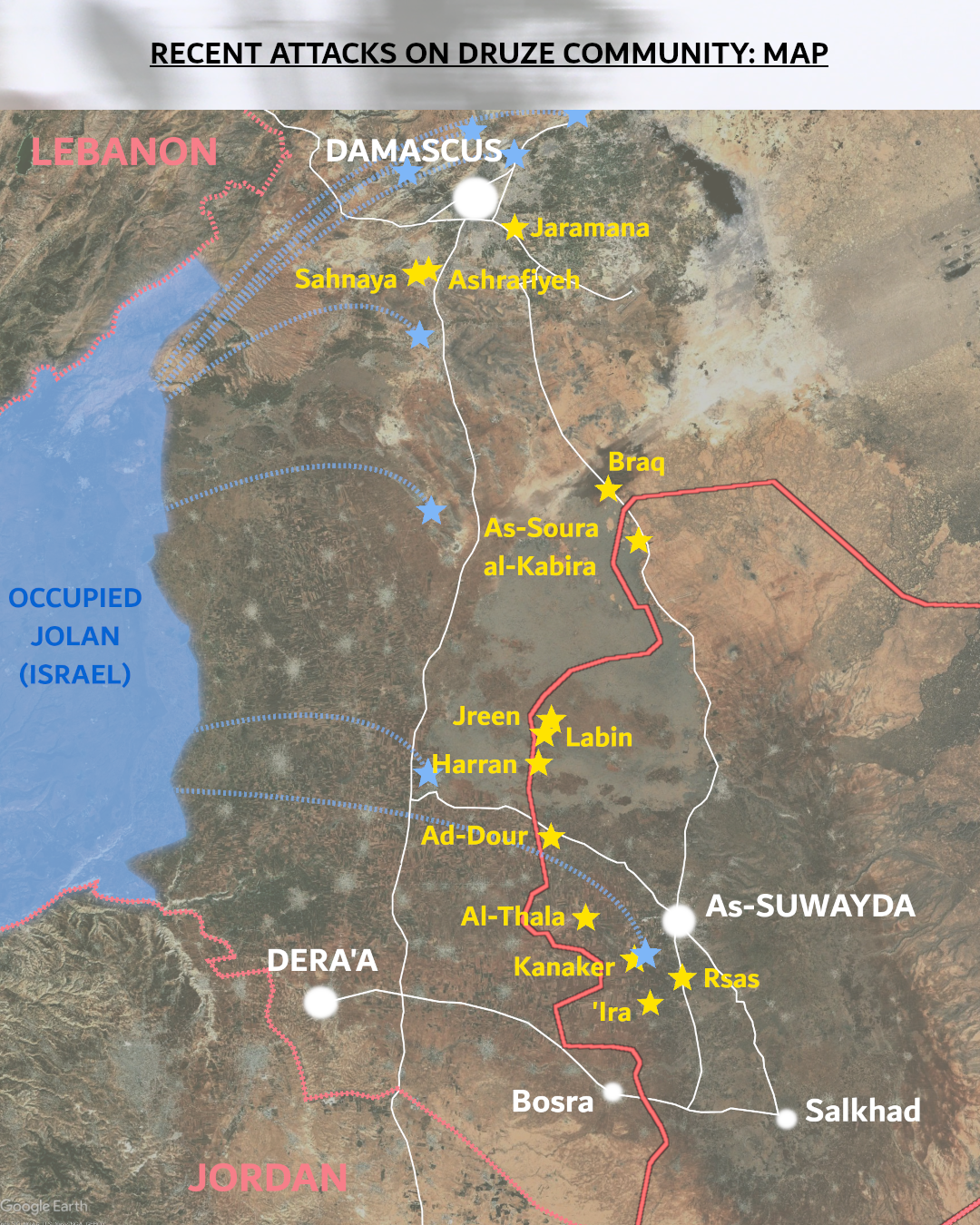Suwayda 2025: Chronology of a predictable Massacre
This work, which aims to restore the facts hour by hour from the beginning of the assault on the communities of Suwayda, has been carried out based on our own experience on the ground, testimonies from our relatives and members of Suwayda’s civil society (whom we refuse to refer to as “Druze” since the community includes Christians, Bedouins, and some Muslim families native to the region and non-Bedouins), as well as a review of all the Facebook posts from several local media outlets that objectively reported the events during the period from July 12 to 22, 2025:
- Al-Raased: ~175 posts
- Aram News: ~180 posts
- Suwayda24: ~95 posts
- Suwayda Media: ~145 posts
In addition to these, the publications from the main actors in the conflict between July 12 and 26, 2025, were included:
- Gathering of the Southern Tribes (Tajmua Asha’er al-Janub): 332 posts
- Legion of the Mountain of Dignity (Liwa Jabal al-Karama – leader: Shakeeb Azzam): 49 posts
- Movement of the Men of Dignity (Harakat Rijal al-Karama – leader: Yahia al-Hajjar): 30 posts
- Sheikh Hikmat al-Hajari: 15 posts
- Army of the Unitarians (Jaysh al-Muwahidun – leader: Oussama al-Safadi): 9 posts
- Forces of the Sheikh of Dignity (Quwat Sheikh al-Karama – leader: Raafat Baali): 9 posts
- Suwayda Military Council (Majliss al-Askari as-Suwayda – leader: Tareq al-Shufi): 6 posts
- Madhafe of Dignity (Madhafe al-Karama – leader: Layth al-Balous): 5 posts
- Gathering of the Free Men of the Arab Mountain (Tajmua al-Ahrar Jabal al-Arab – leader: Suleiman Abd al-Baqi): 1 post
Finally, much of the information has been cross-checked with the following OSINT news and documentation sources:
- Live UAMap Syria: https://syria.liveuamap.com/
- @syrdoc (telegram)
- @sweida_massacres (instagram)
- @verify.sy (instagram) / https://verify-sy.com/
According to the official version of events, everything began on the evening of July 11, 2025, with the abduction, theft (vehicle, 5 tons of fruits and vegetables, 7 million Syrian pounds, and his phone), and torture of Fadlallah Naeem Dwara, a merchant from al-Kharsa (Suwayda), near the Braq /al-Masmiyeh checkpoint.
It should be noted that this checkpoint controls the junction of the roads between Damascus, Suwayda, and Deraa, and it has been held since May by members of the Al-Naim tribe from Mteleh, who do not officially answer to the orders of the Al-Sharaa regime. Several fighters controlling this checkpoint wore balaclavas and Islamist insignia (shahada and the flag of the Islamic State).
Fadlallah Naeem Dwara was then thrown, bound, on the side of a road, from where he managed to reach Route 110 and was picked up by passing drivers, who took him to the hospital.
However, it is important to note that the region between Braq and Mteleh is home to criminal groups that have been committing abuses and crimes against users of Route 110 between Suwayda and Damascus for many years. Everything suggests that these groups, as well as the unidentified armed men controlling the Braq/al-Masmiyeh checkpoint, were involved in the kidnapping of Fadlallah Naeem Dwara, and that the new power in Damascus—like the regime of Bashar al-Assad for years—has exploited this isolated incident to justify a subsequent military operation.
To better understand the events of July, it is necessary to refer to those of the previous months of April and May, which we briefly summarized in our article “What’s behind the sectarian violence against the Druze in Syria ?“
Saturday 12 July
(13 press publications)
3:00 PM to 10:00 PM
The relatives of Fadlallah Naeem Dwara respond to his assault by kidnapping two, then eight Bedouins who come from Suwayda and Al-Hasakeh with the help of a faction from Ariqa (bordering al-Kharsa), demanding in exchange the return of Fadlallah Naeem Dwara’s truck.
The Suwayda electricity company announces a power cut on the high-voltage line supplying the governorate at the level of al-Kaswa and Sheikh Meskin.
Tensions and exchanges of gunfire occur in Shahba, in the Bedouin neighborhoods of Shaqrawiya and Mansoura, followed by mediation attempts by the sheikhs of the various communities involved. A first casualty, Rami Faysal Naeem, is admitted to the Suwayda hospital after being shot in the head. The Gathering of the Southern Tribes announces a return to calm by late evening.
Sunday 13 July
(75 press publications)
Shortly after 10:00 AM, members of the Shanabla tribe from al-Maqwas (associated with the Syrian-Jordanian sheikh and businessman Rakan Al-Khudeir, leader of the Gathering of the Southern Tribes and notorious drug trafficker) kidnap five residents from Suwayda on the Suwayda-Damascus road.
At 11:00 AM, the intervention of community sheikhs (notably Youssef al-Jarbou’a) and efforts to mediate an end to the escalation remain unsuccessful, and armed clashes begin in the al-Maqwas district, a predominantly Bedouin neighborhood on the outskirts of Suwayda city.
Around 12:00 PM, the Internal Security cuts the road between Suwayda and Damascus.
Shortly before 3:00 PM, two initial casualties are brought to the Suwayda hospital from al-Maqwas, having been shot in the chest and head. In the following minutes, the number of injured increases to over seven, while the al-Maqwas district becomes the site of heavy weaponry clashes (mortars and RPGs) between armed Bedouin groups and Druze factions. Clashes also occur in al-Khreij.
3:30 PM – Statement: Sheikh Hammoud al-Hennawi issues a first statement calling for reason and the end of tensions that are damaging social peace.
The faction from Ariqa announces its decision to release the kidnapped Bedouins following the mediation of the sheikhs.
At 5:00 PM, six deaths are confirmed at the hospital, while residents of al-Maqwas are caught between the two warring sides: the children Yaman Muqlad and Zyad Mazen Dalal, Nabil al-Helu, Aamer Kukash, Emad al-Atrash, Omar Munzer, and Raeed al-Qantar. Several elderly individuals are also treated for injuries from sniper fire: Naifa Hussein al-Falah, 80, Salma Belieh Falihan, 60, Aid Ali Salihi, 82. Additionally, 30 more wounded are reported, all from al-Maqwas.
The Gathering of the Southern Tribes announces the death of two members of the Al-Amar clan, as well as 7 additional injuries.
Around 5:30 PM, an armed group from Braq attacks the first General Security checkpoint located close to the Bedouin village at the northern entrance to Suwayda province. The members of General Security in charge of this checkpoint belong to the Suwayda community, as per the agreement signed between the government and Druze leadership on May 1. The village of al-Sawara al-Kbira is also targeted by mortar fire from this same armed group.
At 5:45 PM, residents of al-Maqwas call for calm and urge not to succumb to the logic of violence. They demand the end of the clashes, the release of hostages, and the initiation of dialogue between the conflicting parties. The spiritual sheikhs of Suwayda call on the government to put an end to the abuses of criminal armed groups on the Suwayda-Damascus road.
Around 6:00 PM, a seventh death is reported at the Suwayda hospital, along with 32 more wounded. Sniper fire is reported on the routes linking Suwayda to Atil and Qanawat.
At 6:20 PM, the governor of Suwayda, Mustafa Bakkur, issues a statement calling for calm, as do the residents of al-Maqwas.
At 7:00 PM, the number of injured treated at the Suwayda hospital rises to 54.
Around 8:00 PM, tribal groups from outside Suwayda launch an attack from the Suwayda-Izraa road on the villages of At-Tira, Harran, Lebbein, and Jrein located on the western border of the governorate, while the villages of Mazraa and Sami’ are shelled with mortars.
The attacks continue at the Internal Security checkpoint south or Braq, as well as against al-Sawara al-Kbira and Hazm. Clashes persist in the Bedouin neighborhoods of al-Mashourb, al-Harubi, and al-Mansoura.
Three residents of the villages of Um Rwaq and Maf’aleh are killed: Aamer Nassar Nassar, Omran Al-Aqabani, and Basel Najem Ghanem. The death toll rises to 13 with more than 50 injured.
9:30 PM – Statement: Sheikh Hikmat al-Hajari publishes a statement denouncing attempts at sedition. The number of injured now reaches 80.
Shortly before 11:00 PM, a mortar shell hits the home of faction leader Suleiman Abd al-Baqi in Suwayda, injuring four of his men.
Three more people die at the Suwayda hospital: Hamoud Naseeb al-Arbid, 65, Jalal Ghassan Abu Ghazi, 21, and Walid Fouad Al-Ish’oush. Two residents of al-Majdal are also killed in al-Tireh: Ehsan Ahmed al-Shater and Khaldoun Salman al-Shater.
Monday 14 July
(75 press publications)
Around 1 AM, the governorate is completely placed under siege, while the Rijal Al-Karami movement frees the village of al-Tireh. The group publishes a statement denouncing the violation of the agreements made with the regime in May, which included a promise to restore security on the same road. It reminds the community of the necessity to ensure its self-defense.
Shortly before 2 AM, the mediation of Sheikh Youssef Jarbou’a results in the release of hostages from Suwayda held by Bedouin tribes in exchange for the release of their own hostages.
The first images showing the abuses in al-Tireh are broadcasted.
Around 5 AM, tribal groups from Dera’a restart their offensive against the villages of Ta’ara, Al-Dour, Sami’, and al-Dweire with heavy mortar fire and drones. The village of Kanaker is also targeted by mortar fire.
Before 8 AM, Israeli airstrikes begin over Suwayda, while the Ministry of Defense and Interior announces the deployment of troops and heavy weaponry at the governorate’s borders, claiming they are intervening to “end the clashes and restore security.”
Following this, the government forces launch an offensive on Suwayda as follows:
- The 70th Division of the Syrian Army (based in Rif Dimashq and commanded by the former leader of Jaysh al-Islam Issam Bouidani aka Abu Hammam) and Bedouin groups from Al-Lajat formerly affiliated with DAESH (including the group under the command of Abu Hudhaifa) enter the province of Suwayda from Housh al-Hammad (North). They enter Hazm with the help of the notable family Abu Al-Ezz, particularly the gangster Adnan Abu al-Ezz, who facilitates the entry of government forces into several villages along the Damascus road, especially by promising them a peaceful entry.
- The 40th Division of the Syrian Army (based in Deraa and commanded by the former leader of Ahrar al-Sham Binyan Ahmad al-Hariri aka Abu Fares), the Ali Bin Abi Talib Brigade of the 52nd Division of Special Forces (based in Talkalakh, Homs, and commanded by Haitham al-Ali aka Abu Muslim al-Shami), and the General Security Forces (Ministry of Interior) enter the province of Suwayda from Bosra al-Harir (West).
- Two other fronts are opened by the government forces from Umm Walad and Bosra al-Sham (South) towards al-Thaala, Kanaker, al-Mjemer, ‘Ira, Rsas and Sahwet Blata.
- From within Suwayda, tribal groups affiliated with the Southern Tribes Assembly launch aggressive offensives against al-Mazraa, al-Thaala and Kanaker from the Bedouin neighborhoods of al-Mansura and al-Shaqrawiya. Attacks are launched towards Suwayda and Qanawat by the tribes of Suwayda also from the Bedouin neighborhoods of al-Maqwas, al-Mashourib, al-Haroubi and Rajm al-Zaytoun, making intensive use of suicide drones and mortar shells.
The army does nothing to stop the tribal groups’ progress, instead benefiting from their support to advance along the axes Bosra al-Harrir – Ta’ara and Umm Walad – Kanaker.
10:20 AM – Press Release: Emir Hasan al-Atrash publishes a statement in which he declares that he is in talks with the regime as well as the Druze spiritual leaders to find solutions to the conflict.
10:40 AM – Press Release: Sheikh Hikmat al-Hajari also publishes a statement in which he rejects any presence of the regime’s army in the region and calls for international protection.
Shortly before 1 PM, government forces control Sami’, al-Dour, al-Tireh and Kanaker. Half an hour later, they also control Ta’ara, Qarrasa and Najran. Druze factions announce the death of 22 of their fighters near al-Thaala and Kanaker, bringing the total number of deaths to 64 people. Among the fighters is a comrade-in-arms of the local revolution hero Khaldun Zein ed-Din, Baha Abdullah.
At 1:15 PM, Israeli aviation conducts a first strike on tanks of government forces at Sami’
Hundreds of displaced people flee the combat zones, and reception centers are opened in Salkhad and Shahba.
Around 1:45 PM, Druze factions prevent the Red Crescent from entering the Bedouin neighborhood ofal-Maqwas, which they place under siege. Forty fighters from the government forces and their Bedouin auxiliaries have been killed by this point.
By 2:30 PM, the military airport of al-Thaala comes under the control of government forces. Thirty minutes later, they enter al-Mazraa with the help of Laith al-Balous, leader of a small armed group of about twenty members who pledged allegiance to the new regime earlier in the year.
Videos start emerging on social media, published by the tribal groups. These videos notably reveal the involvement of foreign fighters.
Numerous mortar shells are fired by the tribal groups on nine villages as well as the city of Suwayda, while 200 wounded individuals are reported at the Suwayda hospital.
The Druze leadership, as well as the Medical Corps of Suwayda, call for an end to all violence.
The tribal groups and the regime’s army seize Labin, Harran, Dor, al-Mazraa and al-Mjemer. The occupied villages are subject to systematic destruction and looting of homes.
Around 4:30 PM, government forces attack Rsas, south of Suwayda, while clashes take place between Druze factions and tribal factions in Atil, north of Suwayda. Twenty minutes later, the strategic post of Tel al-Hadid is taken. An arms depot is seized in al-Mazraa.
At this point, Suwayda’s national hospital reports 53 dead, including women and children, and over 200 wounded. Al-Hakma Hospital states it has received 40 wounded individuals, one of whom died from their injuries: Asim al-Qontar.
Israeli aviation conducts a strike in the vicinity of al-Mazraa.
The Druze factions temporarily regain control of al-Sawara al-Kbira.
Around 7:40 PM, Israeli aviation conducts three more strikes on al-Mazraa and Kanaker. An hour later, intense fighting is underway at Walgha.
Sheikh Hikmat al-Hajari meets with several sheikhs from Mayamas at his home in Qanawat. A drone strikes the city, causing light material damage.
7:50 PM – Press Release: The Druze leadership demands a ceasefire and the expulsion of the Islamist groups responsible for the aggression.
Around 9:20 PM, government forces control Walgha.
Around 10:30 PM, a first phase of negotiations between the government and Druze leadership fails.
Four missiles hit the city of Suwayda, and three mortars fall on al-Qurayya, which is 20 km to the south, outside the combat zone.
Tuesday 15 July
(84 press publications)
Around 5:00 AM, the attacks resume at the village of Kanaker.
Statement: The Druze leadership declares acceptance of the entry of the regime’s army and requests that it secure the military and internal defense institutions of the governorate, inviting the regime to dialogue, urging Druze self-defense factions to cease resistance, cooperate with the army, and surrender their weapons. Sheikh Hikmat al-Hajari joins this statement, despite his opposition to Al-Sharaa’s government.
Following this, the Ministry of Defense and the Interior announce their deployment in the center of Suwayda, along with the imposition of a curfew until further notice. They call on the residents not to allow fighters to use their homes as a base to target government forces. Many civilians attempt to flee the city, causing traffic jams at the southern exit of Suwayda city.
At 8:55 AM, government forces reach the Omran roundabout at the northwest entrance of Suwayda city.
9:30 AM – Statement: Sheikh Hikmat al-Hajari issues a new statement, retracting his previous one, claiming that he signed it under international pressure.
Photographs are released showing the deliberate burning of the Christian Church of al-Sawara al-Kbira by Islamist groups and the regime’s army, which had stormed the village two days earlier.
The director of the Salkhad hospital, Loui Al-Shufi, announces that the hospital has reached its capacity, treating over 40 injured people.
Around 11:09 AM, Israeli aviation conducts strikes on convoys of government forces between Walgha and Suwayda.
At 11:15 AM, the Ministry of Defense announces the withdrawal of its tanks, expressing the intention to transfer control of Suwayda to the Ministry of the Interior forces and announces a ceasefire, pledging to pursue the perpetrators of crimes and violations. Images are released showing a military convoy, including heavy weaponry, heading towards the exit of Suwayda, while a Military Police convoy deploys within the city.
At 11:20 AM, government forces have already entered the heart of Suwayda city, accompanied by hundreds of Islamist fighters, who begin the systematic destruction and looting of shops and monuments. Under the pretext of disarming factions, these groups enter residential buildings and start the systematic massacre of civilians they encounter. Snipers position themselves in vacant buildings and shoot at civilians trying to move through the streets, while the city is heavily bombarded. The police headquarters and the governorate headquarters are captured.
At 12:20 PM, an Israeli drone strike targets a light vehicle of the regime’s army near the criminal police building, while the Islamists advance on the northeast axis towards the Khaldun Zein ed-Din roundabout and the Qanawat road. Simultaneously, they progress on the southeast axis towards the national hospital, where dozens of wounded are gathered.
Mortars are fired at the city of Atil, located north of Suwayda, while Israeli aviation intensifies its strikes in the city, on the road connecting Suwayda to al-Mazraa and on the axes around Izraa and Bosra al-Harir in the neighboring Deraa province, where government forces and tribal groups are concentrated.
At 1:25 PM, the surveillance video of a store in Suwayda captures the execution of a sheikh in the street by two members of General Security.
The commander of the internal security forces for Suwayda, Colonel Ahmed al-Dalati, and the commander of internal security forces for Deraa, Colonel Shahir Omran, meet with community leaders of Suwayda to discuss the deployment of internal security forces.
Around 2:20 PM, Israeli aviation conducts six strikes on convoys of government forces near the city of Izraa, in the neighboring Deraa province.
Tribal groups continue their war crimes and acts of genocide. Chaos spreads through the city and the forces present, with social media circulating conflicting messages. Civilians are subjected to humiliation, abuse, and summary executions, while the shabiha of the new regime Jamil Al-Hassan and Qutayba Yassin, posing as journalists, spread false information mixed with calls for sectarian hatred.
The first images of summary executions of civilians are released, including the 13 members of the Al-Radwan family, killed at point-blank range in the living room (madhafeh) of their home where they thought they were safe: Wassam Fahad Rizwan, Ashraf Fahad Rizwan, Nasreen Rizwan, Omar Muafagh Rizwan, Imran Muafagh Rizwan, Samer Moazi Rizwan, Satea Reza Rizwan, Rabee Rizwan, Khaldoon Rizwan, Khalid Rizwan, Essam Rizwan, Mamun Sabir Rizwan, Majdi Mamun Rizwan.
Crowds of civilians continue to flee Suwayda through the south.
At 3:20 PM, the Druze factions launch a coordinated counter-offensive. The response strengthens on the northwest axes towards Walgha and southwest towards Kanaker. Outside the city, violent clashes continue around ‘Ira and al-Mjemer. Israeli aviation continues its strikes on Suwayda city, on the road to Bosra al-Harir near Walgha (drone strike).
Just before 4:20 PM, an Israeli strike targets the 175th Regiment of government forces near Izraa, while another targets government forces approaching the Suwayda hospital. Clashes around the hospital are intense.
Suwayda’s medical sources report the execution by a sniper of Dr. Faten Hilal as she was on her way to the National Hospital to assist the overwhelmed staff, as well as six members of the Qordab family at the Sultan Basha roundabout: Hisham Qordab, Fajer Qordab, Leith Qordab, Omran Qordab, Zaid Qordab, Rebal Qordab.
At 5:00 PM, government forces control the National Hospital neighborhood of Suwayda, where they are guided by Suleiman Abd al-Baqi, the leader of the Druze faction (Ahrar Jabal al-Arab) that pledged allegiance to the new government, before launching a raid within the hospital. At the same time, government forces take control of the village and military base of Khulukhleh, north of the province.
At 5:15 PM, a government drone strikes the Druze factions east of the city, near al-Maqwas.
The director of the medical teams at the National Hospital, Dr. Omar Obaid, calls for the conflict parties to respect the hospital’s neutrality and allow it to operate normally.
At 8:00 PM, government forces launch a violent counter-offensive within Suwayda city.
Sources report the abduction of civilians by Islamist groups and regime armed forces, while medical sources count more than 20 summary executions. The disappearance of a couple and their son is reported: Eman Naseeb, Nasir al-Hadwa, and Adam al-Hadwa.
Just before 9:00 PM, government forces enter the village of Thakir, north of the province.
Around 9:00 PM, images of the destruction of the Christian Church of al-Sawara al-Kbira are released as the village is occupied by regime forces.
Several villages in the region, as well as the city of Suwayda, are subjected to intense bombardment, and their streets become the scene of heavy clashes. The Salkhad hospital in the south of the governorate reports being overwhelmed due to the arrival of numerous wounded.
The community self-defense movement Rijal al-Karami issues a statement holding the regime’s army responsible for the deaths of many of its fighters and accusing it of violating the ceasefire agreement signed prior to its entry into the city of Suwayda. It condemns the numerous atrocities committed by the army and the Islamist groups accompanying it, reaffirming the right to self-defense of the Suwayda community.
Wednesday 16 July
(57 press publications)
Around 1:00 AM, the Israeli air force carries out a series of strikes on the road between Walgha and Suwayda, as well as on al-Thaala.
By 1:30 AM, media outlets broadcast images of Sheikh Merhej Shaheen (80 years old), from al-Thaala, in which he is humiliated by tribal factions, who film themselves shaving his mustache. Other videos filmed by Islamists show trucks leaving Suwayda towards Deraa, loaded with furniture looted from homes in al-Thaala.
The city of Suwayda, as well as the villages of Rsas and Sahwet Blata, located 10 kilometers south of it, are subjected to intense mortar bombardments from dawn. Other villages are targeted by Grad rockets, while tribal groups invade homes near the junction of the Rsas and Kanaker roads (south of Suwayda). Three residents are kidnapped and then executed: Muhammad al-Barbour, Ra’ed al-Barbour, and Amjad al-Barbour.
At 9:00 AM, Israeli airstrikes continue targeting government forces stationed in Suwayda and Walgha.
Entire families are killed in Sami’, al-Mazraa, and several other villages, after their homes are raided by the tribal groups posing as members of the General Security.
By 11:30 AM, government forces control most of the city of Suwayda.
The area around Suwayda’s hospital becomes the site of intense clashes, and is targeted by mortar fire and RPG projectiles, as a tank advances toward the building, blocking access to ambulances. Snipers from the regime’s forces set up positions in the hospital bunker, firing on civilians trying to receive medical care. After the confrontations, hospital staff declare the facility out of service and blocked by heavy weaponry, requesting that patients be transferred to other medical dispensaries in the province.
The execution of Dr. Talaat Fawzi Amer, known for his participation in the Syrian revolution against Bashar al-Assad, is announced. Medical staff confirm that all the injuries treated at the hospital are the result of headshots, including those of women and children. Accounts of summary executions and war crimes multiply, with the city of Suwayda being overrun by tribal groups randomly killing residents in front of their homes, looting and setting houses on fire.
By 12:30 PM, government forces advance along the road leaving Suwayda towards Qanawat, the stronghold of Sheikh Hikmat al-Hajari, and violent clashes erupt near the National Museum. Israeli airstrikes intervene with drone strikes.
By 1:20 PM, Israeli airstrikes target government forces in the village of al-Mjemer.
Statement: The Rijal al-Karama movement publishes a statement to honor its fallen fighters and condemn the aggression by government forces, reminding that the Druze factions have continued to call for a ceasefire.
The hospital is heavily bombarded, while its staff is trapped inside. Armed men move through the al-Qalaa and al-Nahdha neighborhoods, firing on homes and attacking residents in their houses.
Citizen Abdullah Al-Baeini is executed in front of his family during a raid on his home.
A demonstration in support of Suwayda is organized in Aleppo.
Between 2:00 PM and 3:00 PM, Israeli airstrikes carry out a series of strikes on Damascus and its outskirts, specifically targeting the Presidential Palace and the Ministry of Defense. Numerous strikes also target the Deraa province.
At 4:20 PM, government forces declare full control over the city of Suwayda and claim to have signed a ceasefire agreement with Sheikh Jarboua, involving Suwayda’s reintegration into the Syrian state. This agreement is rejected an hour later by Sheikh al-Hajari.
The media announces the death of little Tala Husam al-Shufi, killed by a sniper shot to the head. Her father, Husam al-Shufi, is also known for his support of the Syrian revolution against Bashar al-Assad.
In Suwayda, Israeli airstrikes focus on the outskirts of the village of Kanaker, located 8 kilometers southwest of Suwayda, targeting positions launching mortar fire on the city.
Numerous reports accumulate, revealing that many residents are trapped in their homes, hiding in basements or executed in various neighborhoods of the city of Suwayda by both tribal groups and fighters wearing the regime’s army uniform. Members of the regime’s army enter the hospital and execute two civilian volunteers and several wounded patients. Summary executions of civilians are also reported in the city of Shahba, located 17 kilometers north of Suwayda, along the Deraa road. Four people are executed in the village of al-Sawara al-Sughra: Mazen Obaid, Zia’ Obaid, Aseel Kamel Obaid, and Abdullah al-Khatib.
A truck loaded with looted furniture is struck by an Israeli airstrike just as it prepares to leave Suwayda for Deraa.
The governorate remains under siege, with no way out, no electricity, no ADSL, and no phone lines, while the mobile network is extremely unstable.
Many civilians head towards the Jordanian border to escape the fighting and atrocities.
The death toll is reported to be over 300 civilians and fighters.
Mass mobilization of Druze fighters to liberate the city of Suwayda from government forces and tribal groups.
A group of protesters gathers outside the Parliament Building in Damascus to protest the military operation in Suwayda.
At 5:00 PM, government forces take control of Suwayda’s hospital. Engineer Muhammad Buhsas is executed in the lobby by six members of government forces while about thirty medical staff are kept seated on the ground.
By 6:00 PM, government forces control the Msad and al-Raha neighborhoods, in the southern outskirts of Suwayda. The village of al-Kafr, located 11 kilometers southeast of Suwayda, is targeted by bombings. The Red Crescent’s food donation warehouse is destroyed by a missile strike.
A Civil Defense member, Hamza ‘Ammarin, is reported missing while on a mission to evacuate UN members near the Omran roundabout.
At 6:15 PM, clashes spread to the city of Atil, located to the north of Suwayda on the Deraa road. Meanwhile, numerous reinforcements from government forces arrive in Suwayda city.
Statement: Sheikh Hikmat al-Hajari declares that no agreement has been reached with the regime, demands the unconditional withdrawal of all armed forces that have invaded the region, and calls for the continuation of the armed defense of the community.
The western villages of Suwayda continue to be systematically looted, with their goods transferred by tribal groups towards Deraa.
Thousands of displaced people are heading towards the southern region, while all roads out of the Suwayda governorate remain blocked. The national hospital is nearly out of service, and corpses pile up in the streets, with vast areas lacking electricity and running water. Communication networks are nearly non-existent.
8:40 PM – Press Release: The Rijal al-Karama movement releases a statement rejecting the agreement signed by Sheikh Jarboua, asserting that they will not accept any agreement that does not include the total withdrawal of all armed forces committing war crimes in the governorate. They add that they will fight until the last fighter, as long as the invaders have not withdrawn from the cities and villages they have occupied.
At the same time, Israeli aviation strikes multiple times at the entrance of Suwayda.
The UN and the Syrian government jointly condemn the Israeli intervention, while the US Secretary of State calls for the Syrian government to withdraw its armed forces from Suwayda. Once again, this does not concern the tribal groups that are supplementing the regime’s army.
Shortly after 11:00 PM, the Ministry of Defense announces the beginning of the withdrawal of its armed forces. However, this decision does not affect the tribal groups, which maintain their presence in many neighborhoods, including al-Khudher, Nazlet al-A’waj, near the Cultural Center, near the Omran and al-Zanbaqa roundabouts, etc. The national hospital remains under siege.
Thrusday 17 July
(53 press publications)
At around 3:40 AM, Al-Sharaa declares in a statement that he prefers negotiation over confrontation with Israel. He asserts that he wants to pursue the perpetrators of crimes and thanks Turkey and the United States for their mediation efforts.
A video confirms the summary execution of a group of civilians near Chrin Square (recently renamed “Martyr Khaldoun Zein Eddin Square” in honor of a Druze defector from the army who formed a battalion of the Free Syrian Army against Bashar al-Assad in 2012).
A group of Islamist fighters is captured in Suwayda, including two foreign fighters.
Numerous testimonies confirm the presence of many corpses in the streets of Suwayda.
At dawn, the regime’s armed forces begin a retreat while tribal groups maintain control in the city of Suwayda.
Before 9:00 AM, a source favorable to the regime indicates that Sheikh al-Hajari held a secret meeting with several faction leaders at a farm near Qanawat: Amid Jarira (Bairq al-Qahirun), Bahaa al-Shaer, Tariq al-Shoufi (al-Majliss al-Askari fi al-Suwayda), Abu Dhiab (Rijal al-Karamah), Zaher al-Khatib, and Oussama al-Khat.
Between 9:30 AM and 12:00 PM, Druze factions led by Amid Jarira (Bairq al-Qahirun) and Riad al-Shaer storm al-Maqwas, as well as other neighborhoods and villages inhabited by Bedouins (especially around Suwayda and Shahba), where they set houses on fire, and execute and expel Bedouin civilians. The crimes are reported by the Mukhtar of al-Maqwas.
Earlier, 150 Bedouins from Shahba were evacuated to the village of al-Asfar, located east of the province, at their request.
After the withdrawal of government forces, the Druze factions gradually regain control of the city and discover the extent of the destruction and crimes committed. Many corpses are scattered in the streets and fill the rooms and corridors of the hospital. A large number of shops are looted, destroyed, and set on fire.
The body collection in the streets takes 4 hours.
Statement: Sheikh Hikmat al-Hajari publishes a new statement calling for support for the victims’ families, medical teams, and for documenting the crimes. He also calls for the opening of a crossing point with Jordan.
Images of the massacres begin to circulate widely.
At 11:30 AM, the government announces the evacuation of Bedouin civilians to Deraa.
Just before noon, all communication networks in the province are cut off: internet, mobile phones, and landlines.
At 12:00 PM, Sheikh Jarboua renounces the agreement made with the government the previous day, which was obtained under pressure while Sheikh was under the control of government forces.
Around 12:20 PM, the Druze factions regain control of the governorate’s headquarters.
At around 1:00 PM, images circulate showing Bedouin civilians fleeing Suwayda towards Deraa.
The national hospital declares it has received 226 bodies, some of which are still unidentified, and estimates that the total number of victims should exceed 500, most of whom are civilians.
The bodies of 12 members of the same family, the Mezher family, are found in their apartment in the al-Koum neighborhood, including 8 women and girls and an elderly disabled man.
Several bodies belonging to members of the Saraya family are discovered on Teshrin Square.
In several parts of the city, civilian bodies are found in their vehicles riddled with bullets.
At 2:20 PM – Statement: Sheikh Youssef Jarbou’ publishes a statement denouncing a massacre organized under the guise of a “simple security operation,” contrary to Islamic principles, and for which full responsibility lies with the Syrian state and the countries that support it. He calls for humanitarian organizations and international institutions to investigate and document the crimes. He urges Jordan to open its border with Suwayda and also mentions opening a corridor towards the Kurds in Eastern Syria.
At around 3:00 PM, Druze factions clash with tribal factions in Qanawat. Bedouin civilians are besieged.
Netanyahu states that Israel’s help to the Druze in Syria was requested by Sheikh Muwafaq Tarif, the Druze Sheikh of Palestine.
False information and threats are spread from phones stolen from the victims, and an intense disinformation campaign is launched on social media and by mainstream media, including al-Jazeera, al-Arabi, al-Ekhbariya, and SyriaTV. The Druze are accused of massacring hundreds of Bedouins, with the victims portrayed as Bedouins, inciting a wave of sectarian resentment and hatred on social media and across the country.
Most of the fake news is contradicted by the website Verify.sy.
From then on, Bedouin tribes launched a large-scale counteroffensive in several areas of the province.
At around 3:40 PM, tribes from Hauran launch an attack on the Deir Ali area, located 6 km west of al-Qurayya.
An armed group attacks the village of Walgha (5 km northwest of Suwayda).
4:00 PM – Statement: Sheikh Hikmat al-Hajari releases a statement rejecting all violence and calling for Bedouin populations not to be persecuted.
At around 5:00 PM, a video released by al-Rased media shows Bedouins leaving their homes and heading toward buses, while a Druze Sheikh addresses them to reaffirm their solidarity and brotherhood.
From 5:30 PM, Bedouin tribes launch a series of attacks against the al-Maqwas and al-Masad neighborhoods in eastern Suwayda, as well as in Kanaker.
From 7:30 PM, Bedouin tribes gather at al-Mazraa, then take control of the empty villages of al-Sawara al-Kbira and Hazm to the north, then al-Dour and al-Thaala to the west, without clashes with the Druze factions.
At around 10:00 PM, videos circulate showing Bedouin populations being welcomed and sheltered in several public buildings in the region, notably in Shahba, Remet al-Lohof, and al-Kafr. Poor internet network quality prevents local media from uploading them, while rumors start to spread on social media outside Suwayda that these populations are being held hostage.
At around 11:20 PM, Bedouin tribes attack al-Majdal.
Friday 18 July
(51 press publications)
Videos confirm the burning of houses in al-Mazraa.
Around 0:30 AM, a wave of fake news announces the invasion of Suwayda by Bedouin tribes, but the entry of armed groups is only confirmed at Thakir (40 km North of Suwayda) and Walgha (5 km Northwest of Suwayda).
The tribes seize Rdeimat al-Liwa and proceed throughout the night and morning to destroy and loot homes, as well as summarily execute the inhabitants who remain behind.
Around 1:15 AM, the Bedouin tribes announce a general mobilization to attack Suwayda, and thousands of Islamist militants from across the country declare their intent to wage jihad against the Druze. Despite the rumors, the Druze factions maintain control over most of the province, except for about twenty cities and villages in the West and North, which remain occupied by the groups responsible for the crimes committed over the past four days.
The government refuses to send its army to Suwayda, while Turkey and Saudi Arabia declare their support.
Around 7:00 AM, al-Rased announces that Bedouin convoys entered the province from the North but were unable to advance beyond Rdeimat al-Liwa.
Around 10:40 AM, the Bedouin tribes control the area around the Omran roundabout, while all internet and telephone networks are cut off.
11:00 AM – Statement: Father Tony Petros, representative of the Roman Catholic Church of Suwayda, calls for reason and peaceful coexistence.
At 11:45 AM, the Southern Tribes Alliance announces that the Bedouin tribes will restore authority themselves if the state does not do so.
Between 12:00 PM and 2:00 PM, Druze factions launch an offensive towards Walgha, Kafr al-Lohof, al-Majdal, Najran, Smeid, al-Heqof, and take control of the village of Waqam. Shortly thereafter, the Druze factions announce the liberation of Suwayda, then of Walgha, and the flight of the Islamists towards al-Mazraa. The Bedouin tribes continue to hold positions at the Western and Northern entrances to Suwayda city.
2:00 PM – Statement: The Archdiocese of the Roman Orthodox Church of Bosra Hauran and Jabal Arab, represented by Archpriest Antonius Saad, calls for the reopening of roads and the end of the siege, which deprives 300,000 households of water, electricity, medicine, and food.
A new video shows the humiliation of a Red Crescent worker by a member of the tribal groups, who shaves his mustache in front of the camera, as well as the summary execution of medical staff from the national hospital.
Nearly 80,000 families have been displaced from Suwayda due to the violence, heading towards the southern part of the province and the Jordanian border, while a thousand Bedouin families have been displaced towards Deraa.
A video from the al-Rased media (uncertain time, published on 07/20/2025) shows the good relations between the Bedouin and Druze communities of al-Kafr, with the local Druze leadership reaffirming their commitment to shelter and protect Bedouin civilians.
The hospitals of Suwayda and al-Mazraa are out of service.
Shortly after 4:00 PM, the military commander of Rijal al-Karama, Sheikh Abu Dyab, releases a video showing his men having liberated Walgha.
At 4:30 PM, an al-Rased post analyzes the information manipulation, using, among other things, images of massacres in Gaza to accuse Druze factions of committing crimes against Bedouins in Suwayda. The post includes a video showing a member in uniform from the General Security covering an official vehicle with brown paint to conceal the Ministry of the Interior’s logo.
Around 4:45 PM, an armed convoy from the tribal groups positions itself near Barek (30 km Northeast of Suwayda) coming from the desert, where hundreds of displaced people have found refuge in the past few hours. They are unable to advance and simply film the burning of houses left empty by their owners.
Around 5:30 PM, the village of Sahwet Blata announces the death of 19 of its residents, killed in a massacre committed while the armed forces from the Ministry of Defense and the Ministry of Interior occupied the town. The body of an infant is found dead in a cardboard box. Most of the victims belong to the Al-Baeni and Salah families.
Around 6:00 PM, the Civil Defense (White Helmets) releases a statement clarifying the conditions under which one of their team members, Hamza al-Ammarin, was abducted at the Omran roundabout on Wednesday around 6:00 PM, based on an anonymous testimony from a woman in the vehicle who stated he was kidnapped at a checkpoint held by Druze factions. The al-Rased media contests the information based on an analysis conducted in collaboration with human rights organizations, asserting that the roundabout had been under government control since Wednesday afternoon.
Shortly before 8:00 PM, Bedouin tribes control Remet al-Lohof and fighting continues in al-Majdal and the area around the Omran roundabout.
Around 8:30 PM, Bedouin tribes control Najran and the industrial area of Suwayda.
Around 9:20 PM, Bedouin tribes control the strategic post of Tel al-Hadid, located 6 km West of Suwayda city.
The situation remains calm in Walgha and near the Omran roundabout (Suwayda). Clashes continue near Lahtha. Airstrikes are carried out by Israel on armed groups holding positions to the West of the province.
The Druze factions announce the liberation of the village of ‘Ira (10 km Southwest of Suwayda), al-Thaala (10 km West of Suwayda), and Kafr al-Lohof (10 km North of Suwayda), where many houses have been looted and set on fire.
Sixty Druze fighters have been killed in the fighting around Kafr al-Lohof and Lahtha.
Around 10:30 PM, a video is released showing the execution by defenestration of three young men in Suwayda, forced to jump from a balcony by members of the government forces.
Saturday 19 July
(60 press publications)
At 12:15 AM, the Ministry of the Interior announces that all vehicles and weapons are prohibited from entering Suwayda until further notice, and calls on the command center of the Bedouin tribes to withdraw their fighters from Suwayda and hand over their heavy weaponry.
At 7:40 AM, the White House envoy announces a ceasefire agreement between Israel and Syria, also signed by Turkey, Jordan, and their neighbors. The Jordanian army deploys along the Syrian border, while the General Security forces re-enter Suwayda.
At 8:50 AM, the Druze factions announce that the tribes have violated the ceasefire and attempted to seize the road between Umm Zeitun and Shahba, forcing the Druze factions to withdraw from Lahtha.
10:25 AM – Statement: Sheikh Hikmat al-Hajari confirms the deployment of internal security forces by the government around the province to prevent the entry of armed groups, forbids the entry of anyone for 48 hours into the border villages to avoid any actions that could undermine the ceasefire, guarantees protection to Bedouin populations wishing to leave the province, announces the opening of a humanitarian corridor to Bosra al-Harir (Deraa), and calls on civil society and armed factions to act responsibly and coordinate efforts.
At 8:30 AM, the Druze factions continue to respond to the attacks by the Bedouin factions present in the province.
Shortly before 9:00 AM, the General Security forces deploy to al-Sawara al-Kbira.
At 9:45 AM, the fighting continues between the Druze factions and the tribal factions around the Omran roundabout.
Shortly before 10:30 AM, Al-Sharaa thanks the tribes for their mobilization in a public speech.
11:45 AM – Statement: The Rijal al-Karama movement declares that the “terrorists supported by the government” continue to attack the province despite the ceasefire, continuing their criminal actions against the civilian population.
At 1:00 PM, the General Security forces deploy to al-Mazraa.
Tribal groups continue to launch attacks on several axes leading to Suwayda, violating the ceasefire agreement. A video circulates showing these groups rejecting the ceasefire agreement.
The bodies of tribal fighters found in the streets are carrying military ID cards indicating their affiliation with the Ministry of Defense.
The bodies of around twenty members of the Mezher family are found in their home in Suwayda, including women and children.
At 2:30 PM, the U.S. special envoy for Syria, Tom Barrack, meets with the Jordanian Minister of Foreign Affairs, Ayman al-Safadi.
Statement: The Archbishop of the Roman Orthodox Church of Bosra Hauran sends a message to the international community calling for immediate intervention to end the barbaric massacres targeting both the young and the elderly.
At 3:30 PM, the Bedouin tribes still hold several districts of Suwayda city, including the Omran roundabout, where they claim to have seized a weapons depot.
The medical staff of the national hospital in Suwayda declares the collapse of the healthcare system and the inability to evacuate the bodies stored in the hospital compound, as well as the death of patients due to the inability to provide adequate treatment.
At 4:00 PM, the opening of a humanitarian corridor is announced, though the details remain unclear.
At 5:50 PM, the Druze factions from Breiki liberate the village of al-Majdal.
The factions continue to confront scattered armed groups in certain districts of Suwayda.
At 6:50 PM, the Druze factions announce that they have fully liberated the city of Suwayda.
Armed groups attack the cities of Ariqa from Dama, Kafr al-Lohof, and Umm Zeitun using mortars, heavy weaponry, and drones, while many residents remain trapped there. The city of Shahba is also under attack.
Statement: Sheikh Hikmat al-Hajari confirms that the armed actions of the Druze factions have been solely in self-defense from the beginning, and it is the enemy who is violating the ceasefire, with armed gangs continuing to commit crimes against humanity. He calls on the countries that signed the ceasefire to take responsibility and protect the Druze community.
9:00 PM to 11:00 PM
Statement: The Southern Clans Assembly (Bedouins), led by Sheikh Nawaf al-Bashir, declares that reports mentioning the decapitation of Bedouin children are false, calls for the immediate and total withdrawal of all Bedouin fighters, reaffirms peaceful coexistence with the Druze, and calls for reason and dialogue.
Statement: The Patriarch of the Roman Orthodox Church of Antioch and the Levant calls for an end to the massacres that are endangering the coexistence between communities.
A video circulates showing “journalists” participating in the destruction of Druze religious symbols inside private homes.
Sky News reports on the systematic looting of homes by Islamist groups and the large-scale transfer of stolen goods to the Deraa province.
Shortly before 11:00 PM, the government declares that all Bedouin factions have left Suwayda, while some of them attack Shahba after entering Umm Zeitun.
Dimanche 20 Juillet
(52 publications de presse)
At 1:40 AM, Suwayda24 publishes the identities of the three men executed by defenestration, whose crime video had been released on the evening of the 18th. They are the brothers Muaz and Baraa Arnous, as well as their cousin Osama, all from al-Mazraa. The father of Muaz and Baraa was also executed at the same location. The crime occurred on July 15th in the center of Suwayda, near the Military Police building.
At 8:15 AM, a first humanitarian convoy of 40 trucks enters Suwayda from Bosra al-Sham, southwest of Suwayda.
Around 9:40 AM, a video from Al-Raased media shows the Bedouins being sheltered in a reception center in Shahba.
Before 10:00 AM, external Bedouin factions from Suwayda begin a gradual withdrawal from the province, while Druze factions continue to resist attacks north of Shahba and Ariqa.
Looting and arson continue in villages occupied by regime armed forces, which redeploy just before 11:00 AM to the villages of al-Dour, al-Mazraa, and Walgha.
At 11:30 AM, videos showing Bedouin families being received and cared for in reception centers, such as the temporary center in Shahba, are circulated by the Druze community to deny rumors that these families are being held hostage and mistreated.
12:30 PM – Statement: Sheikh Hikmat al-Hajari demands the end of armed actions and the withdrawal of all regime-affiliated armed forces, welcomes the entry of humanitarian aid into the province, and calls for an immediate end to hateful attacks on the community, as well as false media campaigns aimed at stirring hatred. He also demands the restoration of electricity lines and communications, and the release of prisoners and hostages, to be delivered at 6 PM at the village square of Um Zeitun.
Images show the complete destruction of storage warehouses for the Red Crescent in Suwayda.
Around 1:00 PM, a Red Crescent convoy enters the province of Suwayda.
Displaced people from Hayyat and Thakir testify to the on-the-ground circumstances and the unfolding of events, confirming that the attackers came from al-Huquf, Al-Khalidiyeh and al-Dara, where they looted, destroyed homes, and killed inhabitants.
At 1:15 PM, clashes occur around Shahba.
Around 2:00 PM, a doctor in charge at the Shahba hospital announces that it may be shut down at any moment and that communication between hospitals is extremely difficult.
Statement: The UN establishes a list of urgent needs for Suwayda, namely the opening of a secure passage for civilians, entry of medical aid, water and food, and the secure access and protection of humanitarian workers.
A list of 25 Suwayda residents treated at the Deraa hospital is published.
Around 3:45 PM, Israeli aviation carries out new strikes against Bedouin factions gathered around Ariqa and Bosra al-Harir.
Around 4:00 PM, clashes between Bedouin factions and Druze factions take place near Umm al-Zeytun and Majadel.
Factions announce the complete liberation of Um Zeitun, while Ariqa continues to resist Bedouin faction attacks. Gunfire exchanges take place at Remat Hazem.
17 women from Suwayda are safely repatriated to Jaramana from Deraa.
Shortly before 7:00 PM, the Southern Tribes Gathering claims that 5,000 Bedouin civilians are being held hostage by the Druze factions, urging Bedouin factions to return to Suwayda. Around 8:50 PM, the leader of the Army of Tribes, Saad al-Saber, calls for a rally to restart the offensive. A massive gathering of fighters forms in Bosra al-Harir.
Shortly before 10:00 PM, local media broadcasts images of the Omran roundabout (Suwayda) that was liberated during the day: burned bodies are discovered, as well as numerous inscriptions on the walls left by tribal groups, marking their crimes with the names of their tribes and clans: Al-Uqaydat (Deir ez-Zor), Al-Bakkarah, Al-Qaraan (Deir ez-Zor), Al-Shanabla (Suwayda), Al-Fawaghra, Abu Adnan, Abu Saddam, Abu Asa’ad, Abu al-Wafa, Al-Baraz… Some inscriptions also refer to their regions or cities of origin: Inkhil (Deraa), al-Lajat (Deraa), al-Sanamayn (Deraa), Tafas (Deraa), Hrak (Deraa), Maskanah (Aleppo), Hadaba (Aleppo), Al-Quneitra…
Images also testify to numerous violations, destruction, and looting of homes committed by tribal groups and government forces in the villages of Kanaker and al-Mazraa.
Suwayda24 documents the bodies stored at the Suwayda National Hospital: Medical sources report that over 600 bodies have been brought to the national hospital since the beginning of the massacres, noting that this does not include the bodies taken to hospitals in Salkhad, Shahba and Sali, as well as those buried without being brought to the hospital and the numerous bodies still scattered in the streets. 120 bodies have been buried without identification due to their condition or because their families could not retrieve them.
The number of wounded has exceeded 3,000, including 470 severely injured, and hospital capacities have exceeded their limits, with many being treated in temporary centers and under non-sterile conditions.
Monday 21 July
(33 press publications)
At around 2:00 AM, buses enter Suwayda to evacuate prisoners and injured members of the government forces.
At 3:10 AM, a video is released showing the moment when Bedouins tore down a 2008 sign celebrating Suwayda’s victory over illiteracy. The Bedouins seem to confuse the word “illiteracy” (أمية – ‘ammiyye) with “Umayyads” (أمويين – ‘umawiyyeen), thinking that Suwayda was boasting of having gotten rid of the Umayyads (sic). This sign was located on a bridge on the road to Damascus, at the entrance to Suwayda.
At around 8:30 AM, the government organizes the evacuation of the Bedouin tribes with the help of the Red Crescent. Just over an hour later, more than 1500 Bedouins are evacuated by bus from the province.
From 10:00 AM onwards throughout the morning, Druze factions resist attacks from Bedouin factions in Shahba and Umm Zeitun, who make intensive use of drones. This is the thirteenth time tribal groups violate the ceasefire agreement. By 11:50 AM, calm has returned to Shahba, but fighting continues in Umm Zeitun.
Druze factions manage to stop attacks on the village of Ariqa from the three axes of Dama, Najran, and Harran.
At around 12:00 PM, Christian churches in the region announce they have opened their doors to serve as emergency medical centers and are providing vehicles to serve as ambulances.
The U.S. special envoy declares that the Syrian regime must be held accountable.
A list of 25 Suwayda patients treated at al-Razi hospital in Damascus is made public to reassure their families.
Just before 2:00 PM, a video shows the reception of a thousand displaced Druze and Christians at a sports center in Shahba, taken care of by the association “Basmeh al-Watan“.
At around 2:45 PM, new mortar fire hits the city of Ariqa.
From 3:00 PM, many volunteers participate in cleaning the National Hospital of Suwayda. The transfer of bodies from the National Hospital of Suwayda for burial has begun with the help of the Red Crescent. All bodies were photographed beforehand in accordance with legal procedures.
At 4:00 PM, Druze factions announce they have regained control of Umm Zeytun.
The al-Mazraa hospital announces it is operational again.
The Suwayda Bar Association announces its collective resignation to protest the denial of terrorist crimes and massacres committed in the province.
Students from Suwayda living in other governorates are being threatened on social media by Islamists, who are posting their photographs and addresses.
Armed men attack the village of Hayyat.
6:30 PM – Statement: The Rijal al-Karama movement contests false information spread by media complicit in the massacres, claiming that Laith al-Balous is their leader, reminding that he has led his own movement since 2016. It emphasizes that in the face of the aggression against their community, all groups of the mountain are united as one bloc.
A collective of lawyers is preparing a legal file establishing the responsibility of the Director of Security for Suwayda, Colonel Ahmed Haytham Dalati, as well as the Director of Security for Deraa, Colonel Shahir Jabbar Imran, for war crimes.
6:45 PM – Evidence of a new massacre of civilians by the Ministry of Defense and Interior forces emerges: Engineer Samir Hussein Hmidan is found murdered in his wheelchair at home, alongside two family members.
At around 7:00 PM, the same tribal groups who attacked Shahba with drones this morning continue their attacks on the village of Umm Zeitun and the city of Shahba, targeting wheat and flour reserves in a clear attempt to ease the siege imposed by the regime. The youth of Majadel fiercely resist the tribal groups and call for reinforcements, while a tribal convoy suffers heavy losses.
At around 7:40 PM, a video from a Suwayda store’s surveillance camera confirms that members of the government armed forces played an active role in the civilian massacres on July 15th and 16th: a sheikh is shot at close range in the street by men wearing General Security uniforms while walking unarmed. Other videos show raids on private homes and violent attacks on residents.
Testimonies of summary executions continue to accumulate, implicating both tribal groups and government forces.
While calm seems to return, over twenty villages have been completely destroyed and set on fire.
At around 9:40 PM, the Rijal al-Karama movement announces the death of 46 of its fighters since the beginning of the attacks, publishing a list of their names.
A first convoy of fuel tankers carrying fuel and gasoline enters Suwayda from Bosra al-Sham towards the city of al-Qurayya.
Tuesday 22 July
(41 press publications)
Just before 10:00 AM, employees of the Suwayda electricity company, attempting to restore power on the lines near Kanaker, alert to the presence of snipers. The company reports losing several vehicles and 7 of its best employees in the massacres. Videos testify to the crimes and violence committed in the village of Umm Zeitun after the end of the fighting there.
At 12:50 PM, a family from the village of Lebbein testifies to the crimes committed there, while the population of more than 30 villages in Suwayda has been evacuated and displaced due to attacks from government forces and their tribal auxiliaries.
Statement: Sheikh Hikmat al-Hajari calls for the restriction of the sharing of sectarian and provocative posts and speeches, while reminding that the Bedouins are part of the community, should not face any persecution, and must be protected.
Filmed testimonies of victims of the attacks are multiplying, while a new surveillance video made public around 4:00 PM shows members of the government forces engaging in the destruction and looting of shops during their temporary occupation of Suwayda on July 15 and 16.
Videos and photographs testify to the destruction of goods and housing in the village of Najran.
The effects of the siege of the province by government forces for 10 days are beginning to seriously affect the population, who are lacking water due to the total power outage preventing pumps from functioning to draw water from the wells. Meanwhile, numerous fires are mobilizing tanker trucks to help firefighters put out the flames.
Shortly after 8:00 PM, a second convoy enters Suwayda to evacuate Bedouin families to Deraa.
Tribal groups attack the village of Hayyat, where local factions resist the assault and push the attackers back towards al-Mtoneh.
A United Nations delegation arrives in Suwayda and documents the health situation at the National Hospital.
The Syrian Observatory for Human Rights publishes a statement rejecting any investigation into crimes established by government institutions, stating that the experience of the previous commission of inquiry on the crimes of the coast contributed to concealing the truth. It calls for the formation of an independent commission of inquiry under the aegis of the UN.
8:40 PM – Statement: The Archbishop of the Roman Orthodox Church of Bosra Hauran and the Arab Mountain denounces false reports claiming the expulsion of Christians from the province and reminds that they are defending their land and heritage while providing protection and spiritual and community support to the population.
Around 9:00 PM, a new video is released showing the summary execution of Munir Al-Rajma, a resident of al-Thaala (and well guard), by members of the government forces, after he declares he is Syrian when asked if he is Druze.
9:40 PM – Statement: Father Tony Botros, officiating at the Roman Catholic Church of Shahba, denies the evacuation of members of the Christian community from Suwayda.
General Security launches a raid on the dormitories of Latakia University to arrest 11 students from Suwayda.
What has happened since July 22?
In the following days and weeks, the government continued evacuating Bedouin families, using the pretext of putting them in safety to justify the ethnic cleansing of the region. The official number of Bedouins displaced is 28,768, out of a total Bedouin population in Suwayda of about 33,000 people. The government’s objective is that the siege (which serves as both its Plan B strategy of pressure and a collective punishment) imposed on the remaining population (Druze, Christian, and some non-Bedouin Muslim families) does not affect the Bedouin communities it claims to have come to rescue from alleged persecution by Druze factions.
To date, the government has provided no credible evidence of a voluntary and systematic persecution of Bedouin populations, while the accusations of massacres against them have not been substantiated by lists of victims or missing persons, images, or factual evidence allowing the identification and quantification of these killings. Government forces, for their part, have actively participated in the massacres of Druze civilians, which are documented by numerous images – including some filmed by the perpetrators themselves – as well as the names of victims and detailed testimonies from their relatives.
The government falsely accused Druze factions of violating ceasefire agreements, while its armed forces and Bedouin auxiliaries have attacked more than half a dozen cities and villages since the agreements: Shahba, Umm Zeytun, Ariqa, Majadel, al-Majdal, Kafr al-Lohof, Remat Hazem and Hayyat.
The siege continues more than two months after the attacks, preventing any movement between Suwayda and the rest of Syria, while over thirty villages remain occupied by government forces and local tribal factions affiliated with the Southern Tribes Gathering, after being completely looted and destroyed.
The humanitarian convoys of the Red Crescent deliver quantities that are woefully insufficient to feed the hundreds of thousands of residents in the province of Suwayda, and are unjustifiable in light of the situation: if the government did not block traffic and electricity supplies, did not prevent trade, and did not obstruct the return of the 190,000 internally displaced persons to their villages, the population would not need humanitarian aid. Humanitarian aid is thus being exploited by the government and its American, Israeli, Jordanian, Turkish, and Saudi interlocutors to exert blackmail and control over the civilian population according to their own diplomatic and economic interests. The goal is to bring the Druze factions and their spiritual leader to the negotiation table and have them disarm in order to fully submit to the new dictator of Damascus, without jeopardizing the strategic and economic agreements that all these states have begun to establish with Al-Sharaa since the fall of the Assad regime. One thing is fairly certain: the Druze’s aspirations for autonomy, democracy, and security will not threaten the Abraham Accords…
The populations of Suwayda, whether Druze, Bedouin, or Christian, seem to have been manipulated in a strategy whose objectives and stakes are beyond them. And it is clear that the cause of all this is neither the abduction of Fadlallah Dwara, nor the knee-jerk reaction of the armed factions on both sides. Some of the answers to these questions are not found in Suwayda or Deraa, but rather between Damascus, Istanbul, and Deir Ez-Zor, and then between Washington, Riyadh, and Jerusalem…
Map of the military invasion of Suwayda
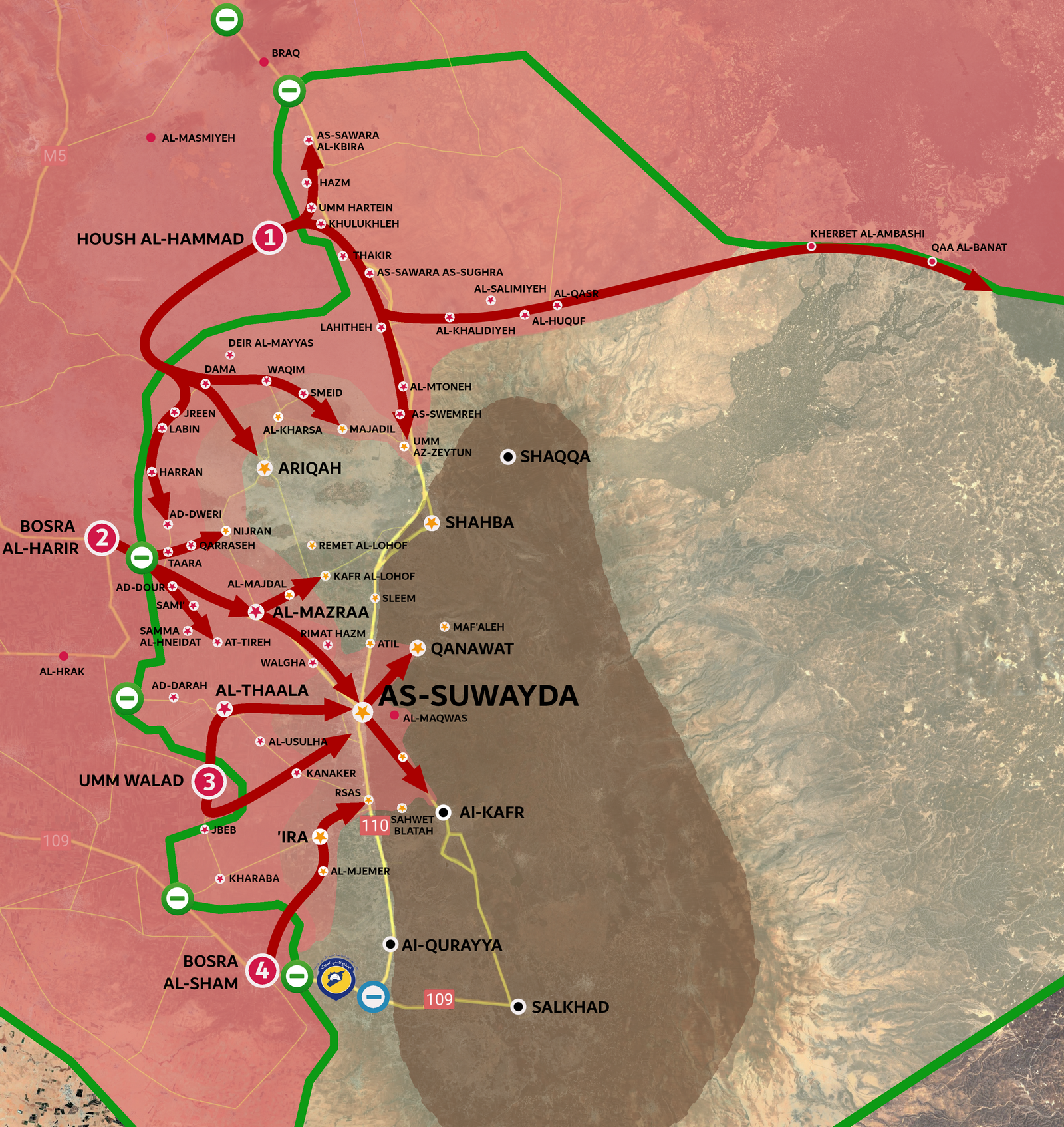
LEGEND:
- Red Zone – Area under regime control before July 22.
- Brown Zone – “Jabal al-Arab” Mountain.
- Numbers on red circles – Major cities in Deraa from where the tribes have departed.
- Red stars on white circles – Cities under regime control (including 30 completely destroyed).
- Yellow stars on white circles – Cities attacked but not occupied.
